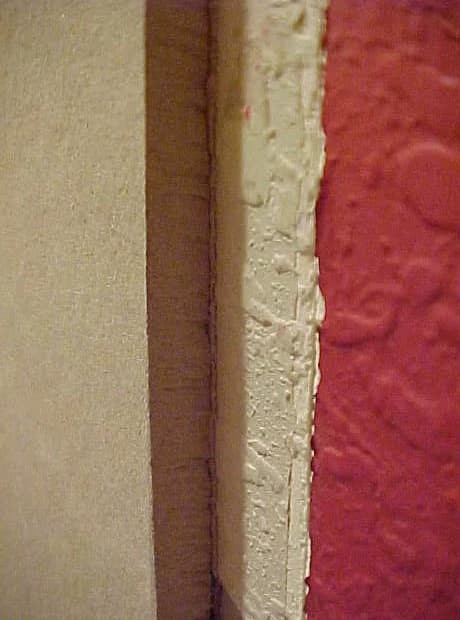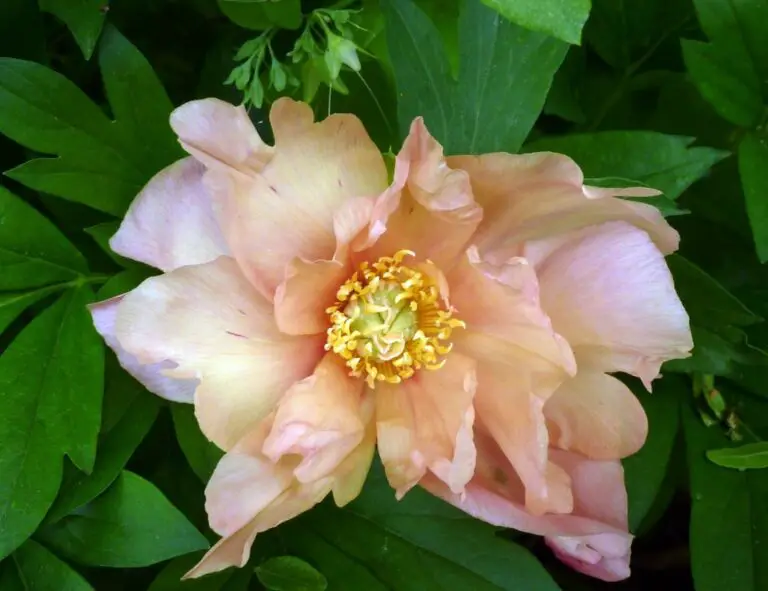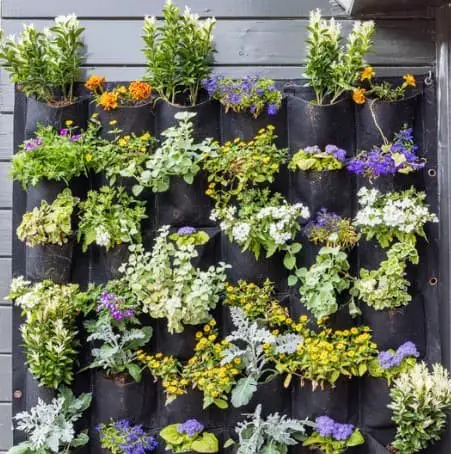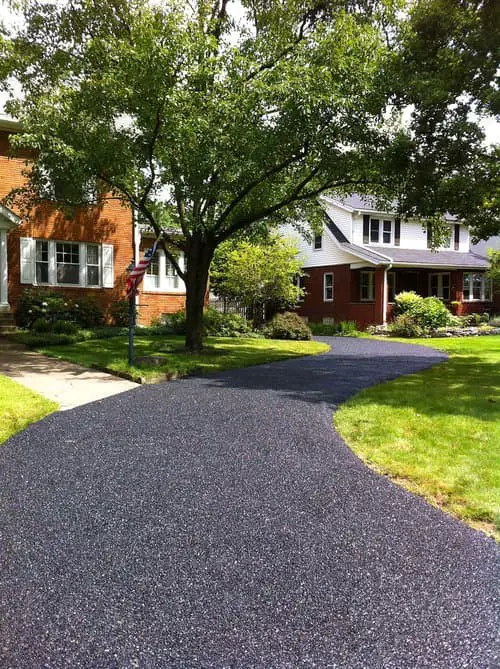20+ Inspiring Japanese Bathroom Ideas For A Zen-Like Atmosphere
Japanese bathrooms have become increasingly popular for their serene and relaxing atmosphere. This design approach, which combines simplicity, minimalism, and natural materials, creates a peaceful oasis that’s perfect for unwinding after a long day. By focusing on clean lines, natural light, and thoughtful use of space, Japanese bathroom designs offer a refreshing escape from the hustle and bustle of everyday life.
In this article, we’ll delve into the essence of what makes these designs so special and explore 20+ unique Japanese bathroom ideas that you can incorporate into your own home. From minimalist design to natural stone tiles, and from soaking tubs to aromatherapy, we’ll cover it all. Let’s start by exploring the key features of Japanese bathroom design, including the use of natural materials, space-saving solutions, and traditional Japanese art and décor.
We’ll also look at how you can maximize space in a small Japanese bathroom and why using aromatherapy can be beneficial. With these ideas and inspiration, you’ll be well on your way to creating a peaceful oasis that’s uniquely yours.
20+ Unique Japanese Bathroom Ideas to Elevate Your Home
Minimalist Design
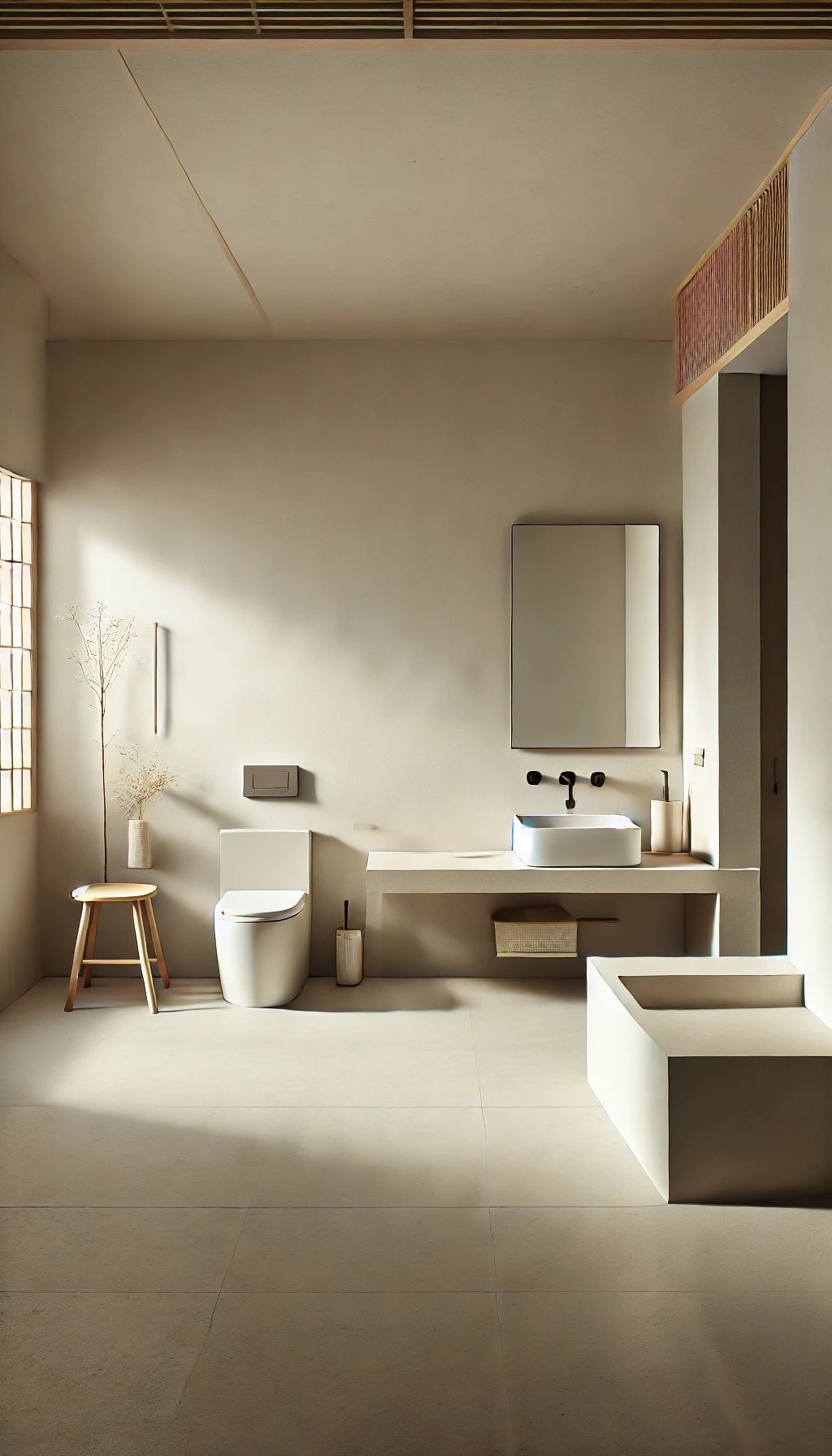
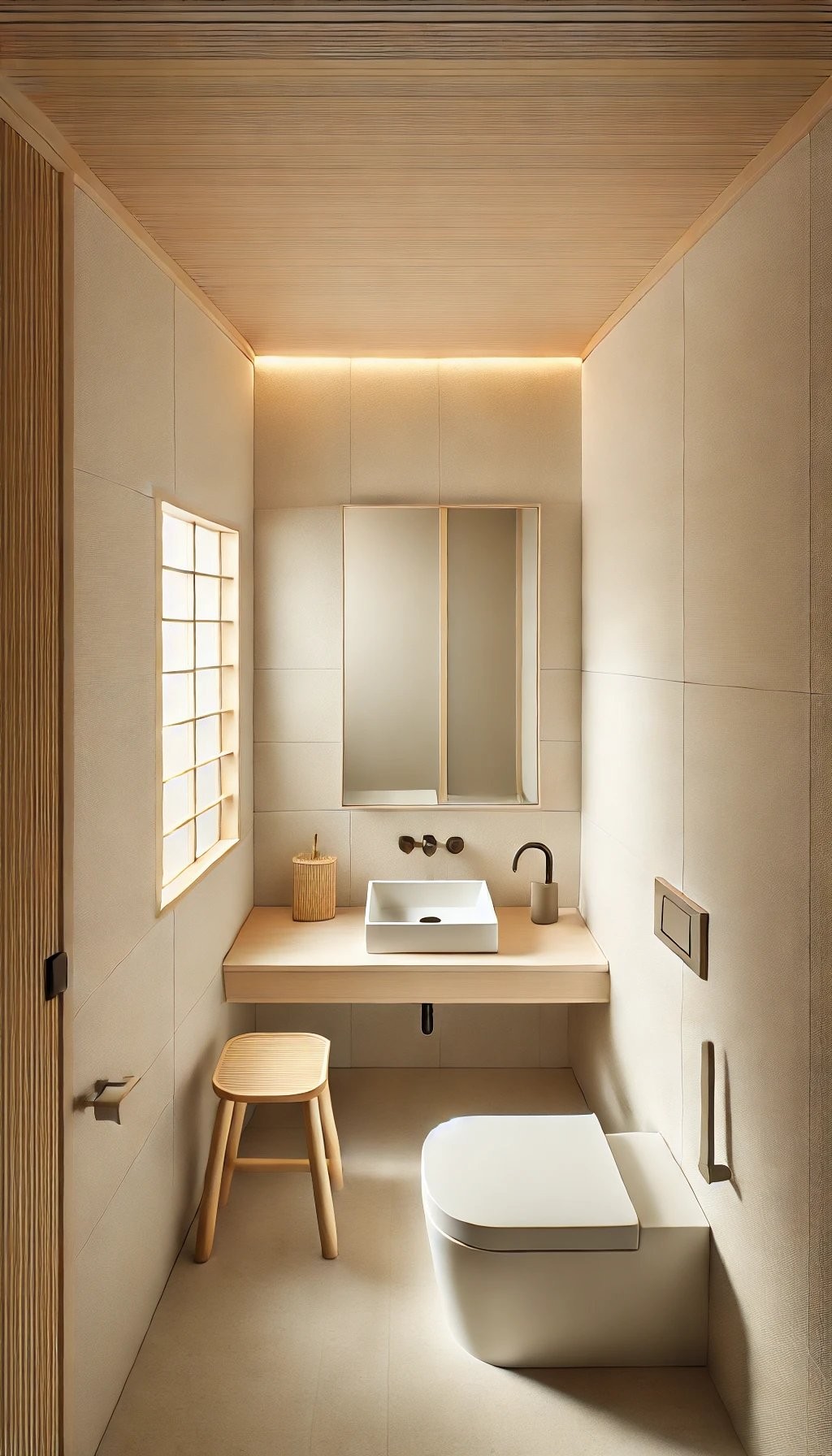
In Japanese bathrooms, minimalism reigns supreme, epitomizing simplicity and clarity. This design philosophy eliminates the non-essential, zeroing in on what truly matters. To recreate this serene atmosphere, opt for neutral color palettes that harmonize with a sleek, unadorned fixture aesthetic. Meanwhile, maintain a clutter-free zone to create an illusion of expansive space, even within a compact bathroom.
The outcome is a tranquil retreat that exudes calmness and serenity, as renowned designer Marie Kondo aptly puts it: ‘The objective of cleaning is not just to clean, but to cultivate happiness living within that environment’.
Use of Natural Materials
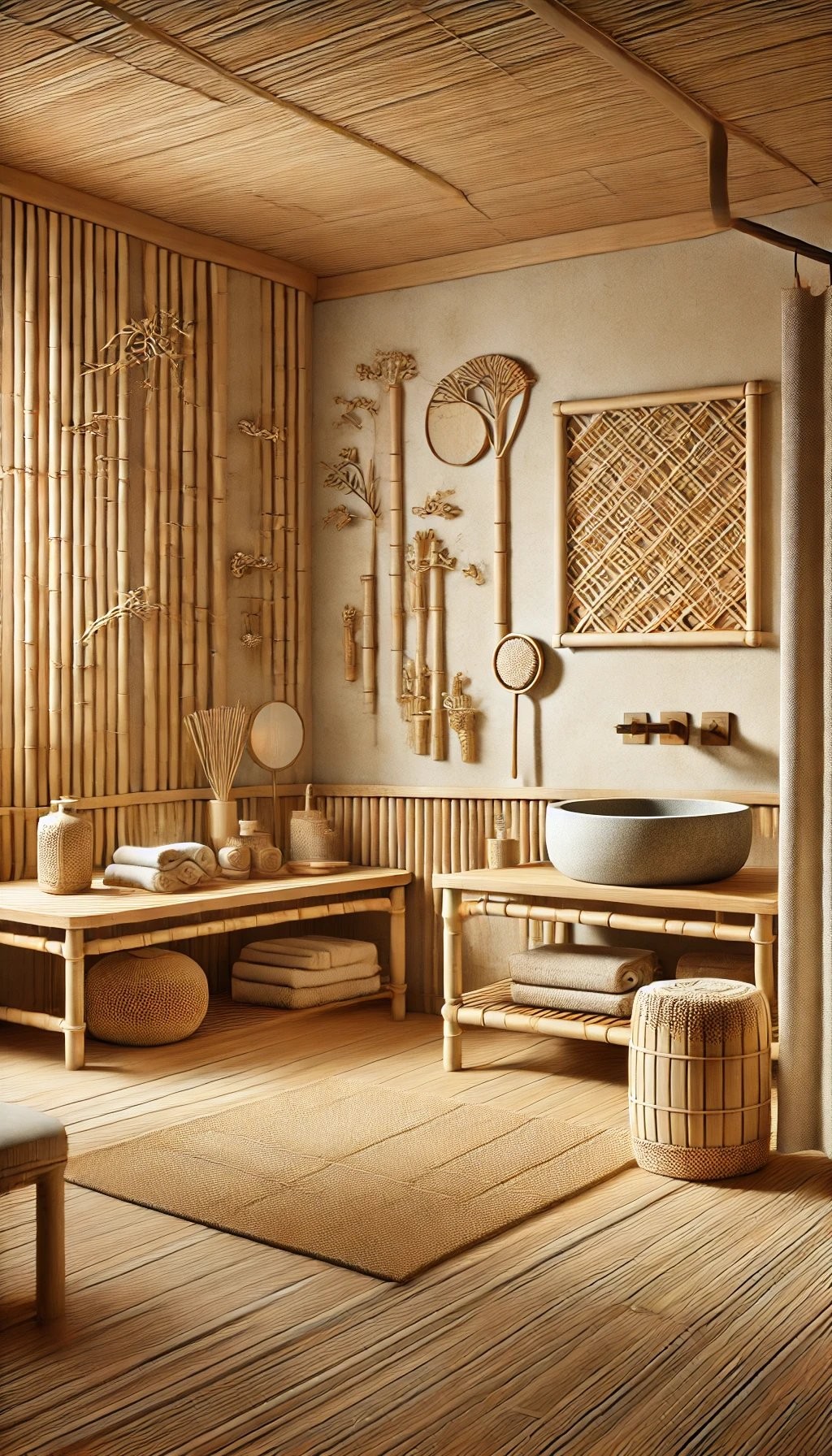

Japanese bathroom design emphasizes the incorporation of natural materials, such as bamboo, wood, and stone, which not only bring a touch of nature indoors but also create a calming ambiance. Wooden bath mats, bamboo accessories, and stone sinks are just a few examples of how these elements can be used to add warmth and texture to the space, making it feel more connected to the natural world.
This philosophy is echoed by renowned Japanese architect Tadao Ando, who notes that wood speaks to our heart, while stone speaks to our soul, highlighting the emotional connection we have with these materials.
Soaking Tubs (Ofuro)


In Japanese bathrooms, a traditional feature is the soaking tub, also known as an Ofuro. These wooden tubs are designed with relaxation and detoxification in mind. Unlike Western tubs, they are smaller but deeper, allowing for full-body immersion in hot water. The benefits of having a soaking tub include reduced stress levels, improved circulation, and a sense of deep relaxation.
When it comes to placement, consider positioning the tub near a window to enjoy a serene view of the garden or in a cozy corner of the bathroom for an intimate setting.
Sliding Doors (Shoji Screens)
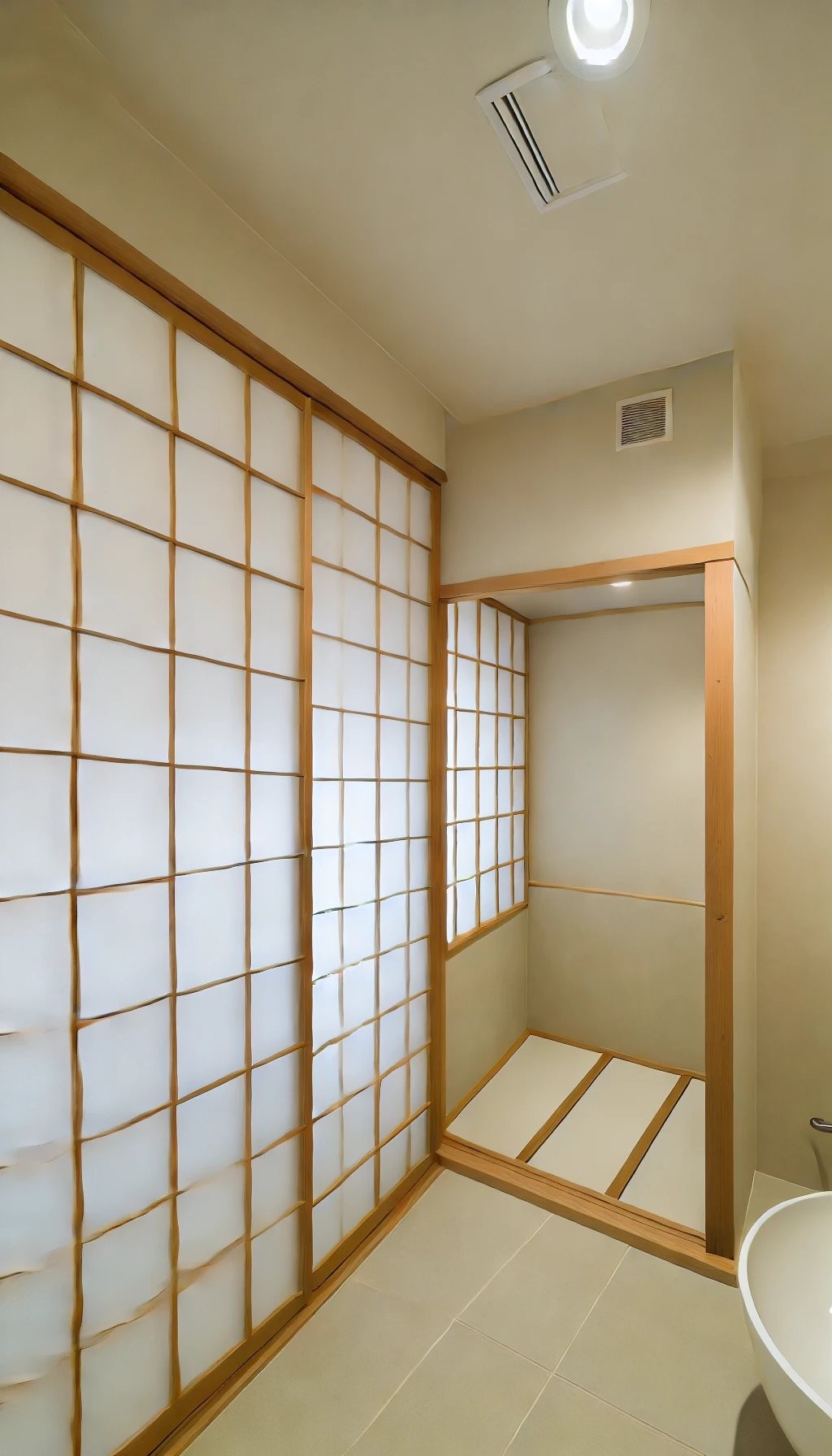
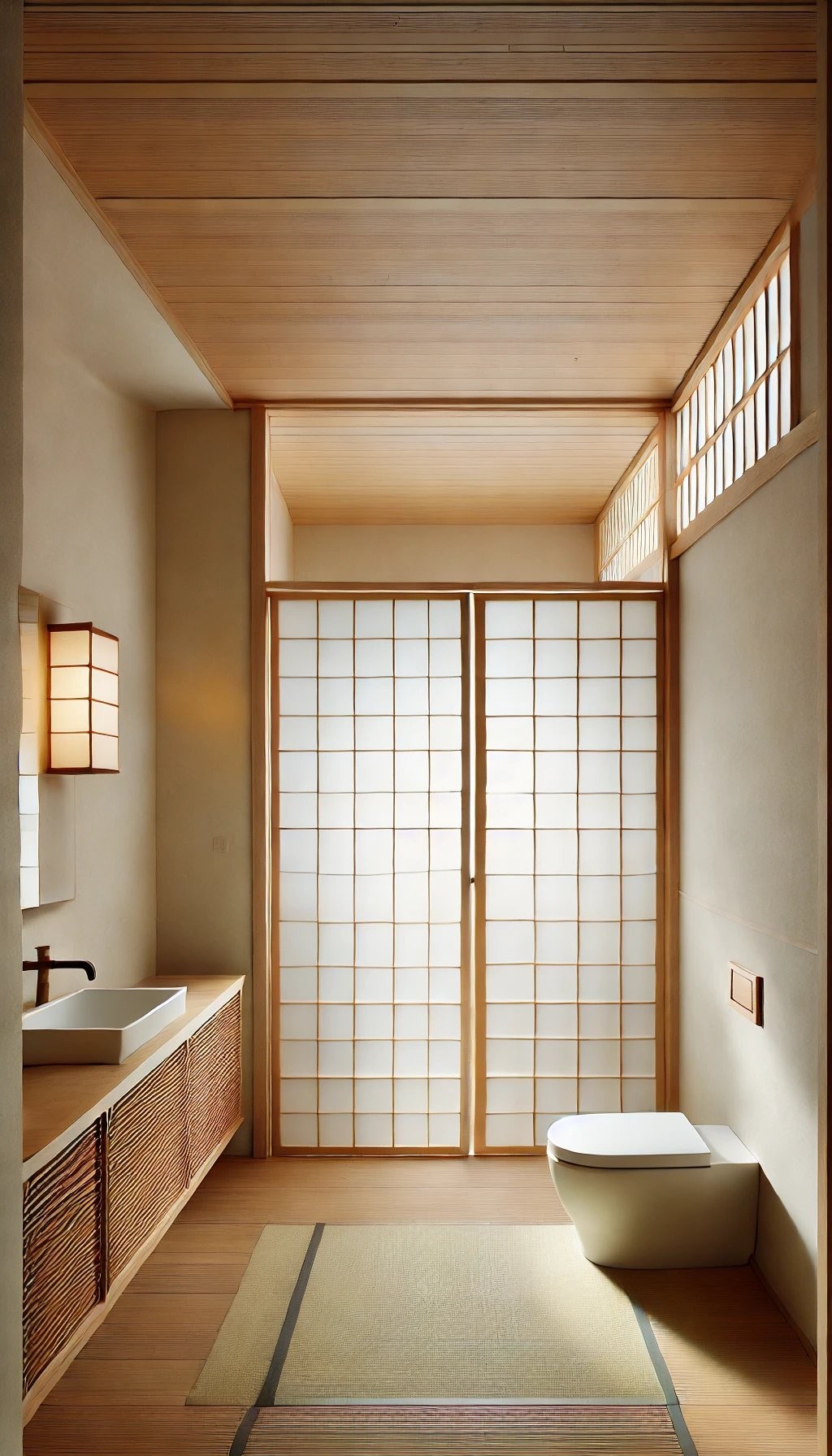
Shoji screens have been a staple in Japanese homes for centuries, offering a unique blend of functionality and aesthetics. These traditional sliding doors are crafted from translucent paper mounted on a wooden frame, allowing them to seamlessly integrate into any room’s design. One of the most significant advantages of Shoji screens is their ability to create flexible spaces that can be easily adapted to suit various purposes.
In addition to providing an open, airy feel, they also allow for soft, diffused light to enter the room, further enhancing its ambiance. When installed in a bathroom, Shoji screens can effectively save space and maintain privacy, all while maintaining a sense of openness. Their traditional Japanese style makes them an ideal choice for adding a touch of cultural flair to any bathroom, expertly separating the bath area from the rest of the room.
Indoor Plants

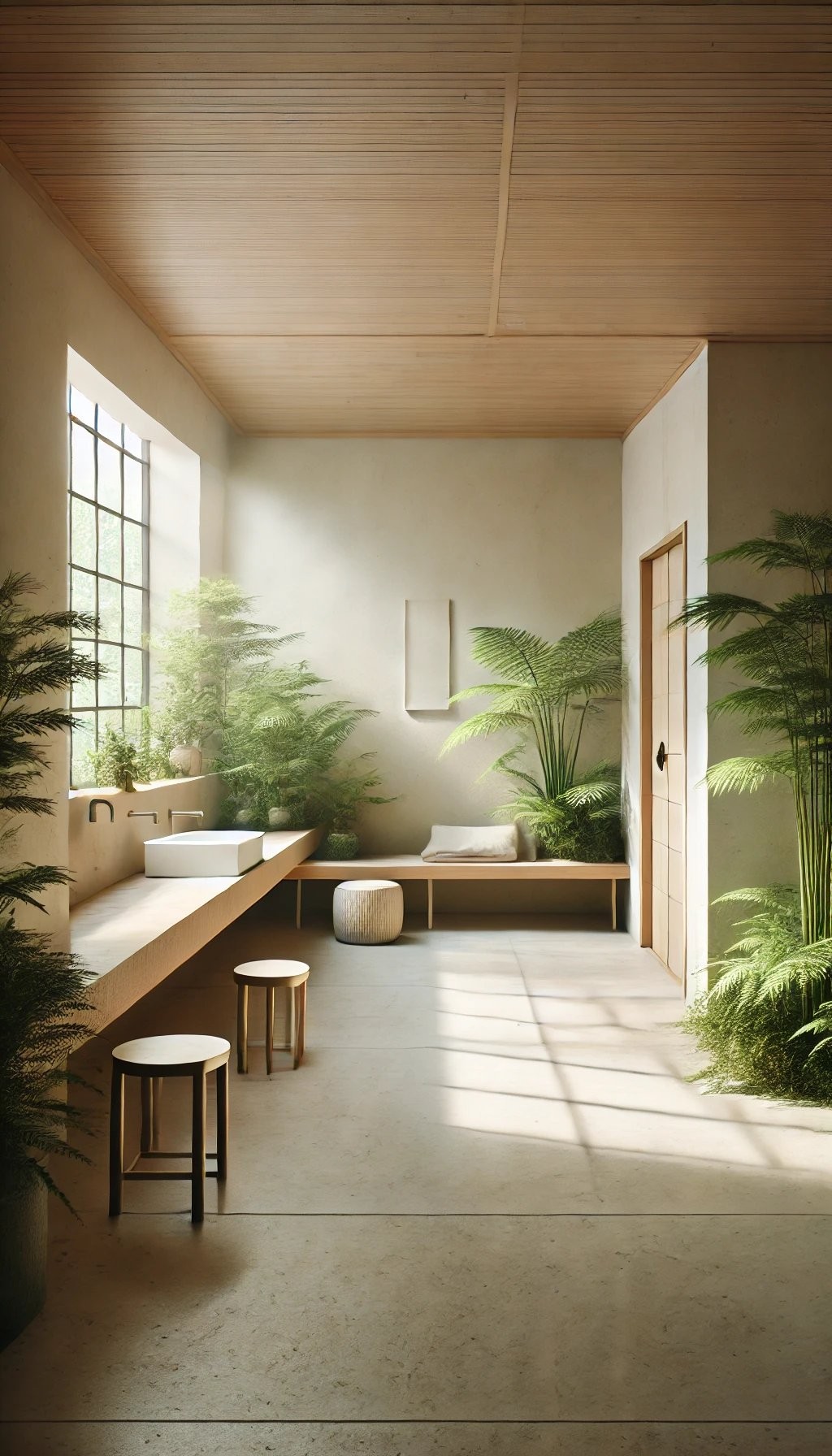
In Japanese bathrooms, indoor plants are instrumental in fostering a serene ambiance. Species such as ferns, bamboo, and orchids flourish in the humid environment, infusing the space with a natural charm. Strategically positioning them on shelves, from ceilings, or near windows allows for optimal light exposure. To maintain plant health, regular watering and proper drainage are essential.
Landscape architect Kazuyuki Ishihara aptly captures the essence of plants in interior design, stating that they ‘bring life to any space, creating a sanctuary of peace and tranquility’
Zen Gardens

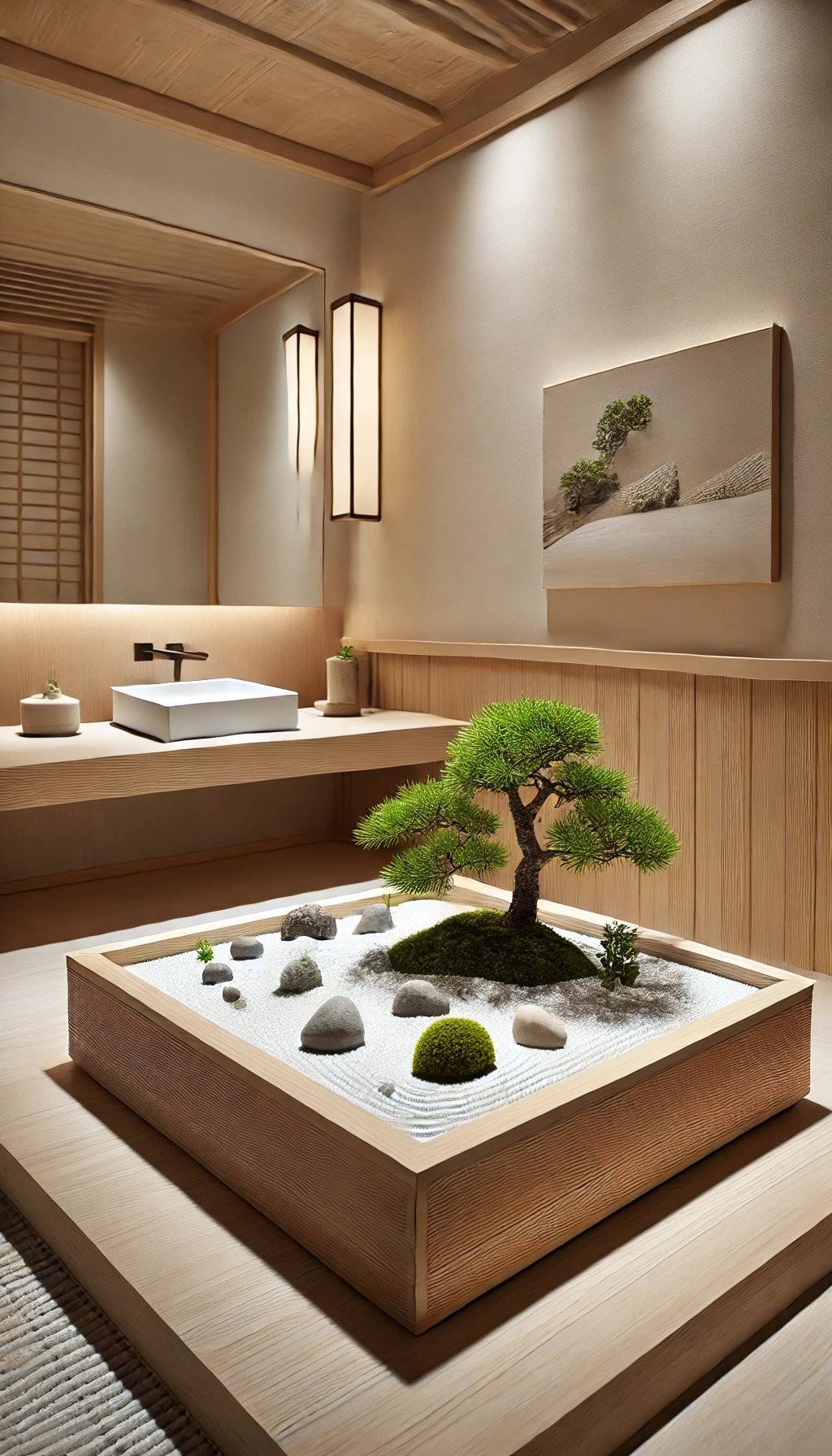
Incorporating a Zen-inspired oasis into your bathroom can be a game-changer for cultivating serenity and mindfulness. To create a mini Zen garden within this intimate space, bring together three essential elements: stones, sand, and small plants. Arrange these components thoughtfully to harmonize the atmosphere, much like Shunmyo Masuno, a renowned Zen priest and garden designer, so eloquently puts it – ‘A Zen garden is a physical space that nurtures the mind.
‘ By doing so, you’ll not only add an aesthetic touch but also invite a sense of calm and contemplation into your daily routine.
Natural Light
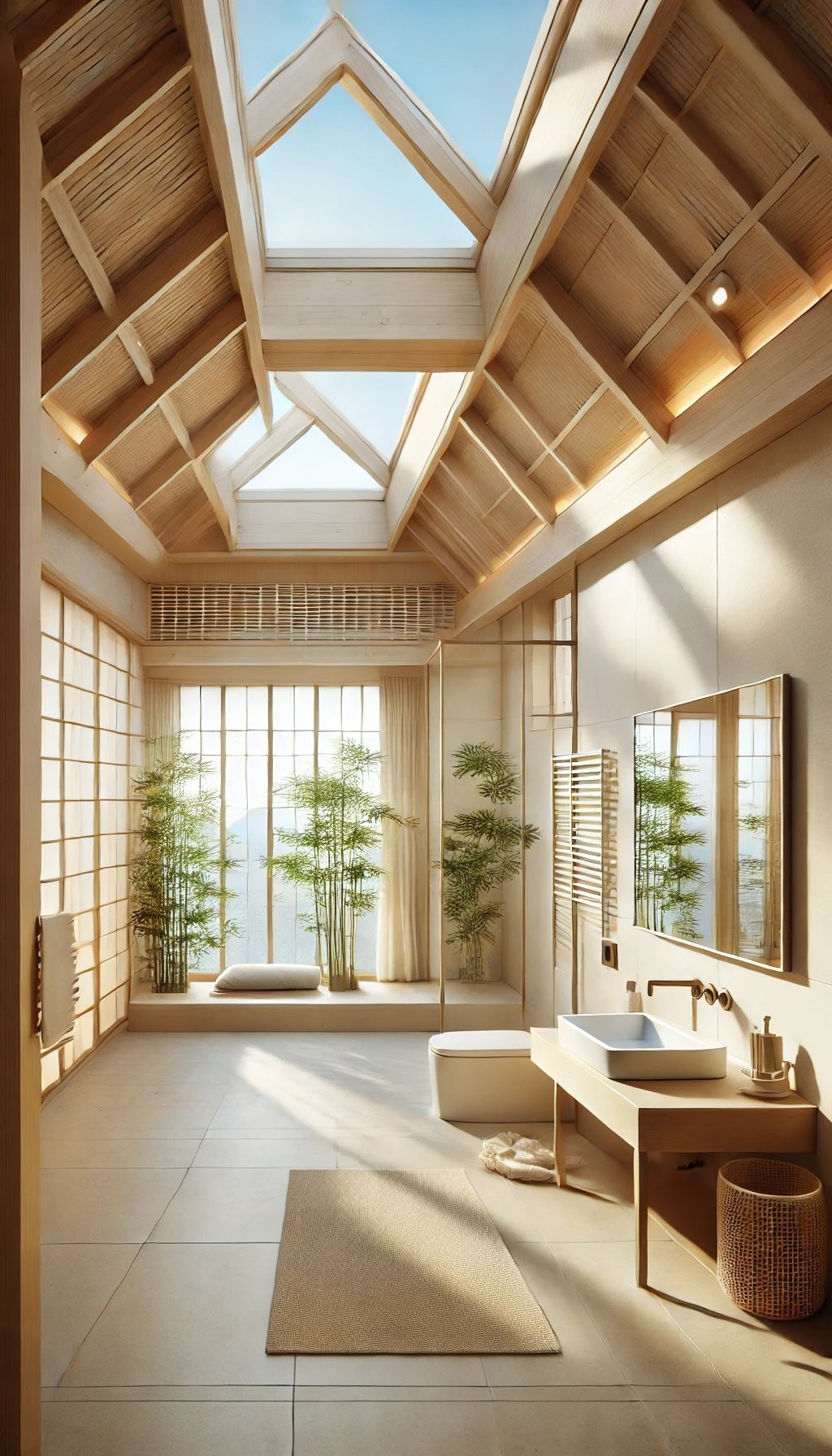
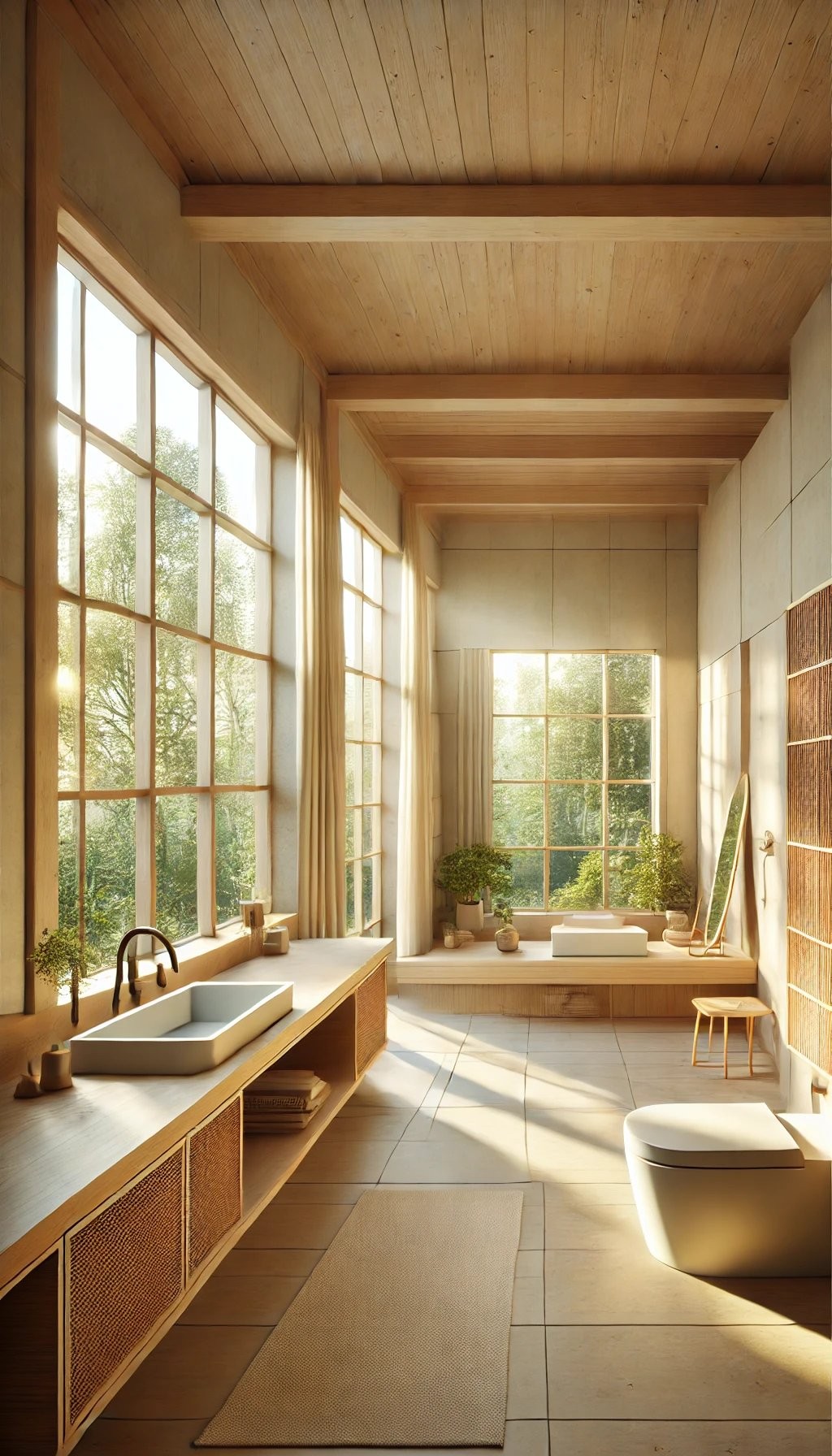
Japanese bathroom design places a strong emphasis on incorporating natural light to create a sense of openness and warmth. This can be achieved by making strategic use of skylights, large windows, and light-colored walls. By maximizing natural light, bathrooms can be transformed into a peaceful oasis that exudes serenity. According to renowned architect Tadao Ando, ‘Light is the key element in creating ambiance and defining space.
‘ As such, it’s essential to incorporate design elements that allow for an abundance of natural light to flood the space, ultimately enhancing the overall aesthetic and functionality of the bathroom.
Earthy Color Palettes

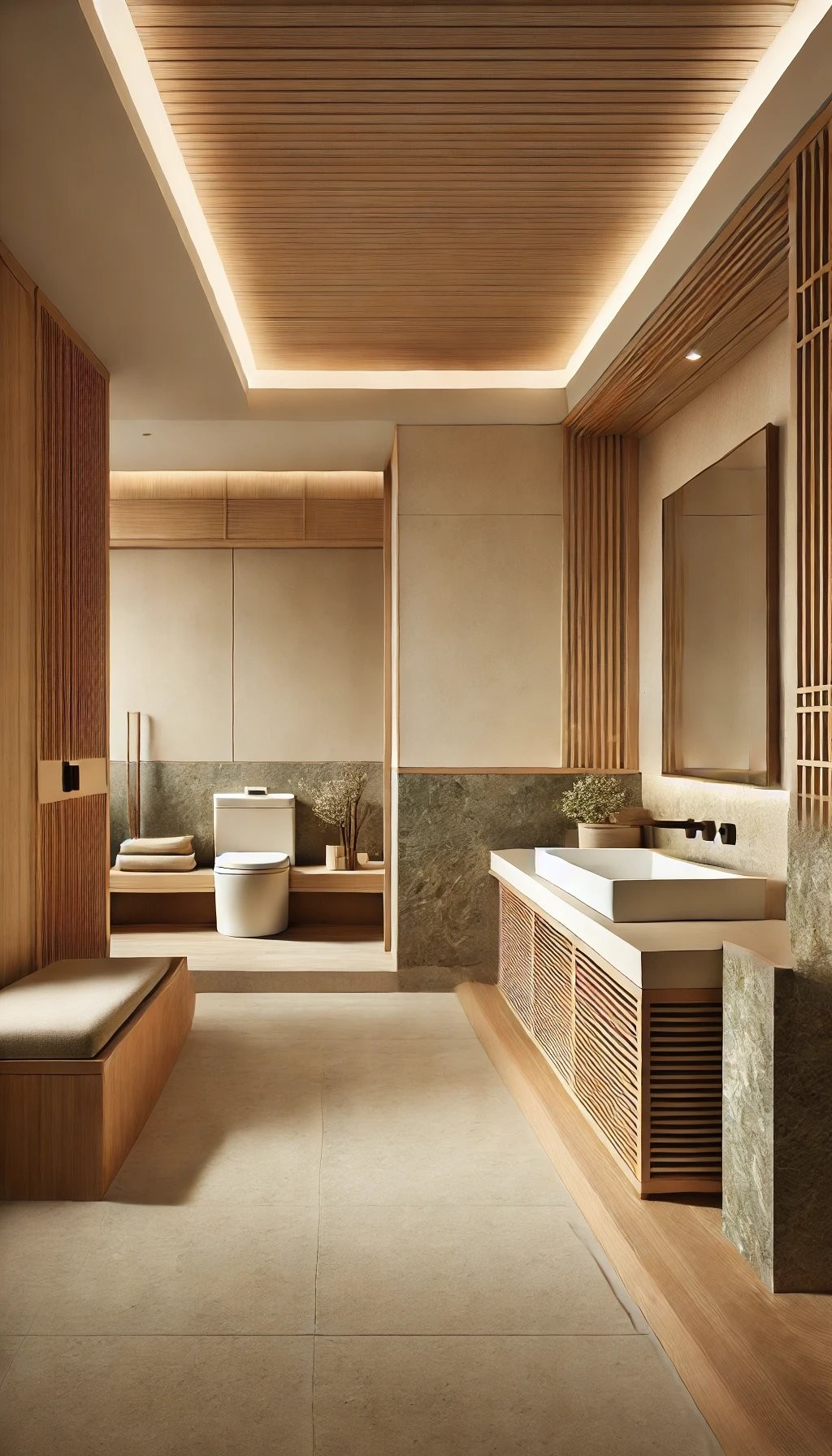
When it comes to Japanese bathrooms, popular color schemes often draw inspiration from the natural world. Earthy tones and neutral shades are particularly prevalent, as they create a calming and serene environment that feels deeply connected to nature. When selecting and combining colors, consider incorporating hues of beige, brown, and green. These earthy tones can be used effectively on walls, floors, and accessories to maintain a cohesive and soothing atmosphere.
As renowned designer Kenzo Takada so eloquently puts it, ‘Colors should be gentle and harmonious, reflecting the simplicity of nature’.
Streamlined Fixtures
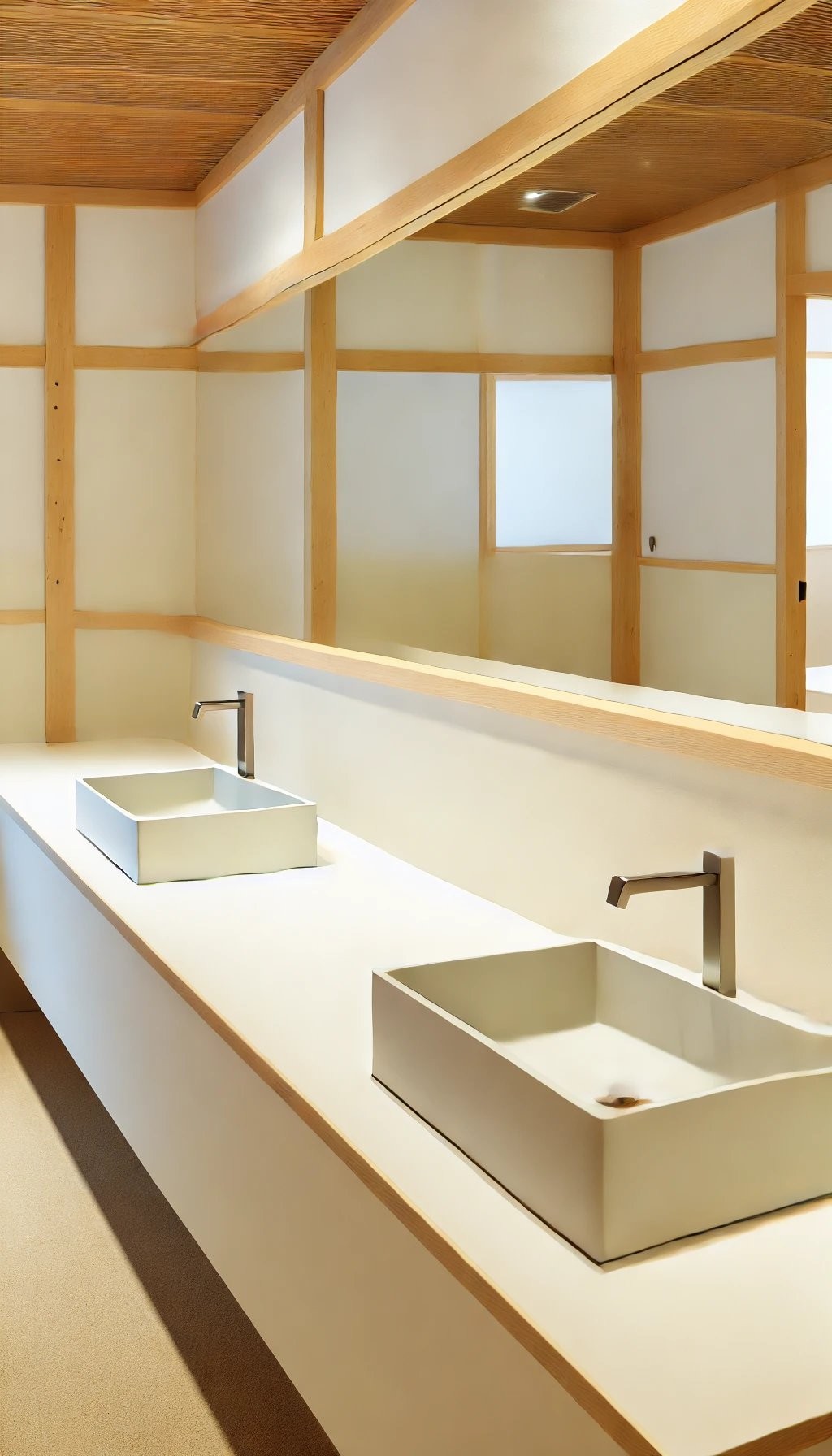
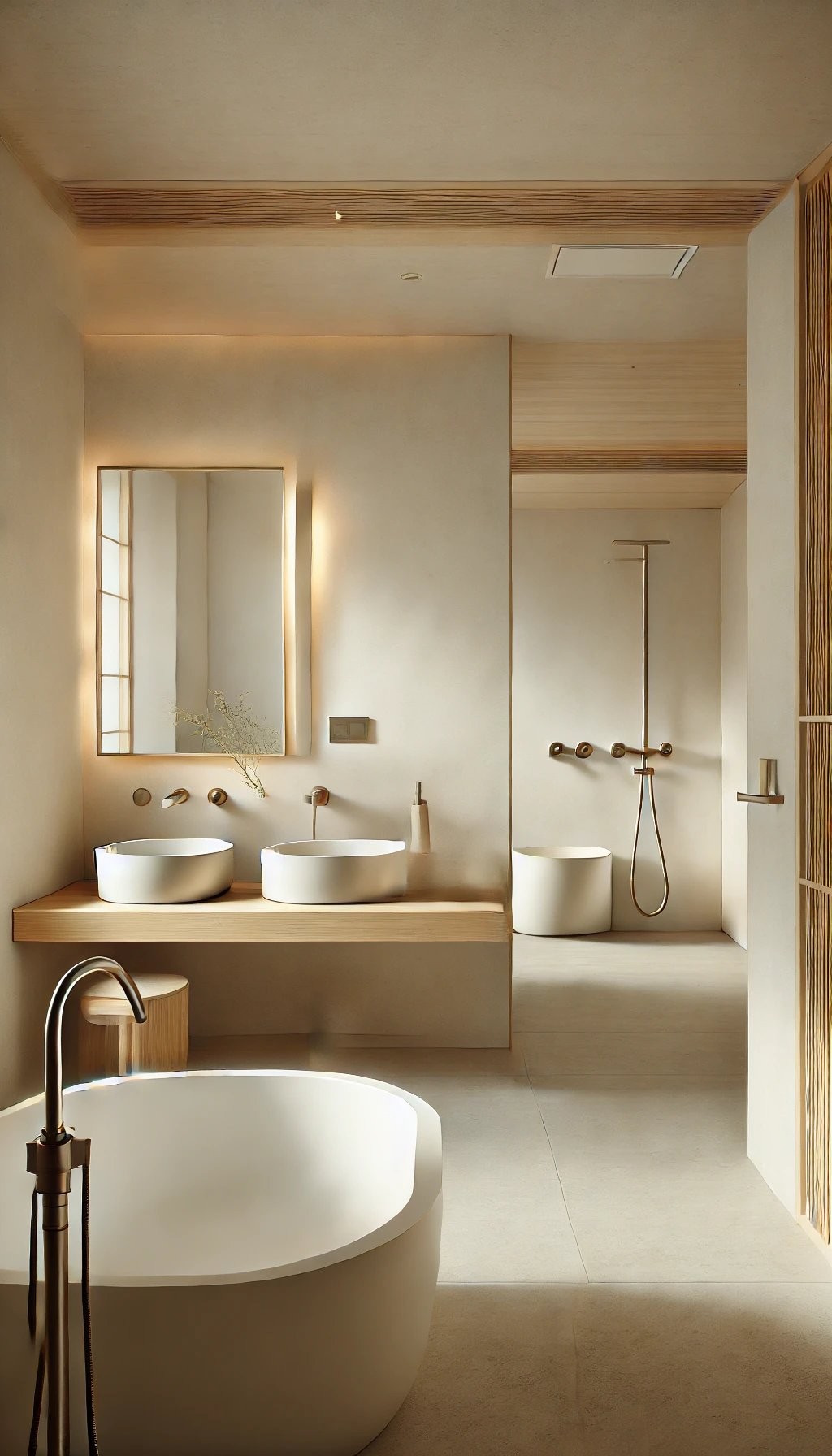
Japanese bathroom design is renowned for its streamlined fixtures, which prioritize sleek, modern, and functional elements. When choosing sinks, faucets, and toilets, opt for designs that strike a balance between simplicity and elegance. The aim is to create a clean and uncluttered aesthetic that visually expands the space. This philosophy is echoed by renowned designer Naoto Fukasawa, who astutely notes that design should be about enhancing daily life, rather than simply being philosophical.
Space-Saving Solutions
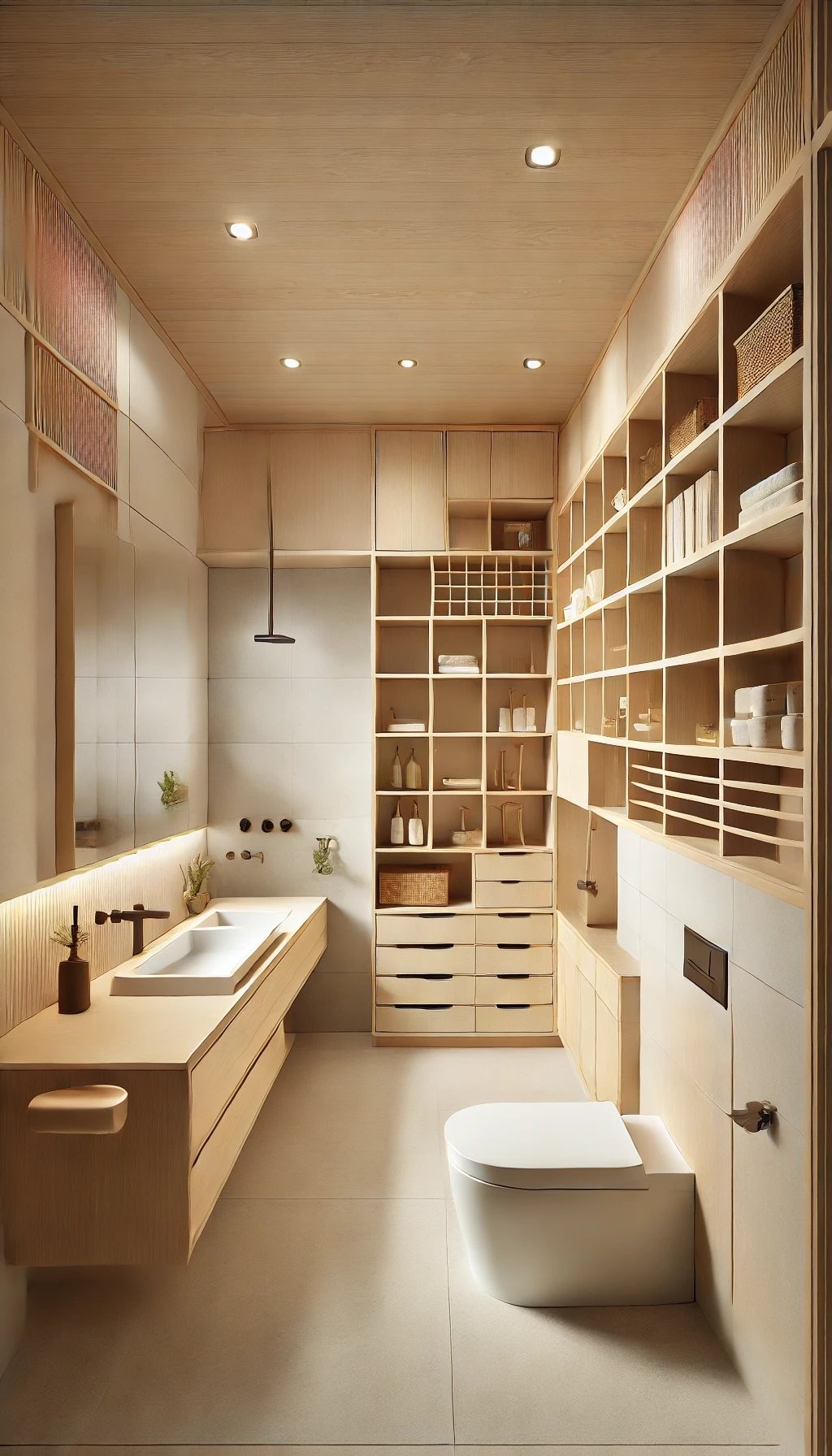
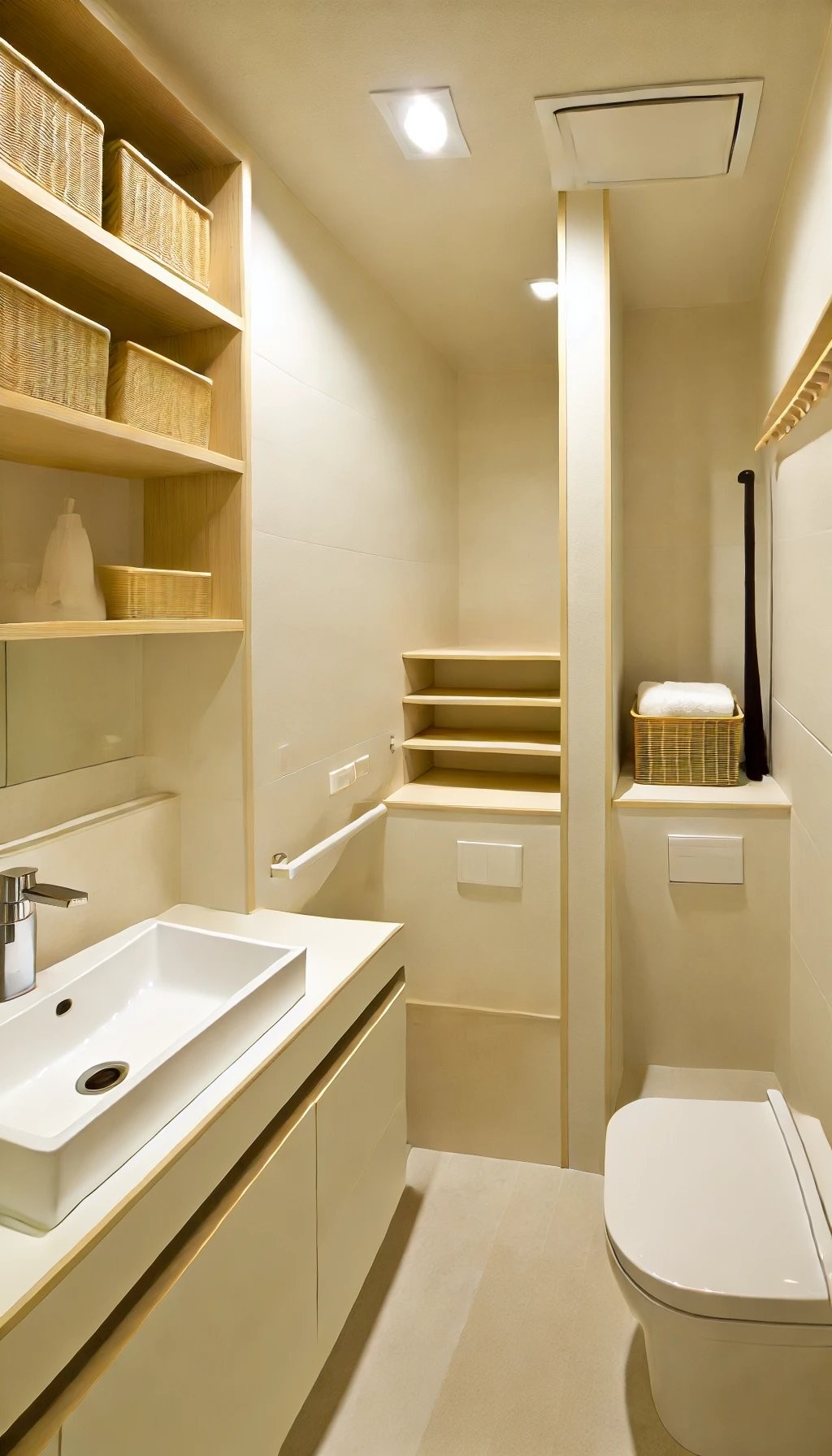
Traditional Japanese Art and Décor
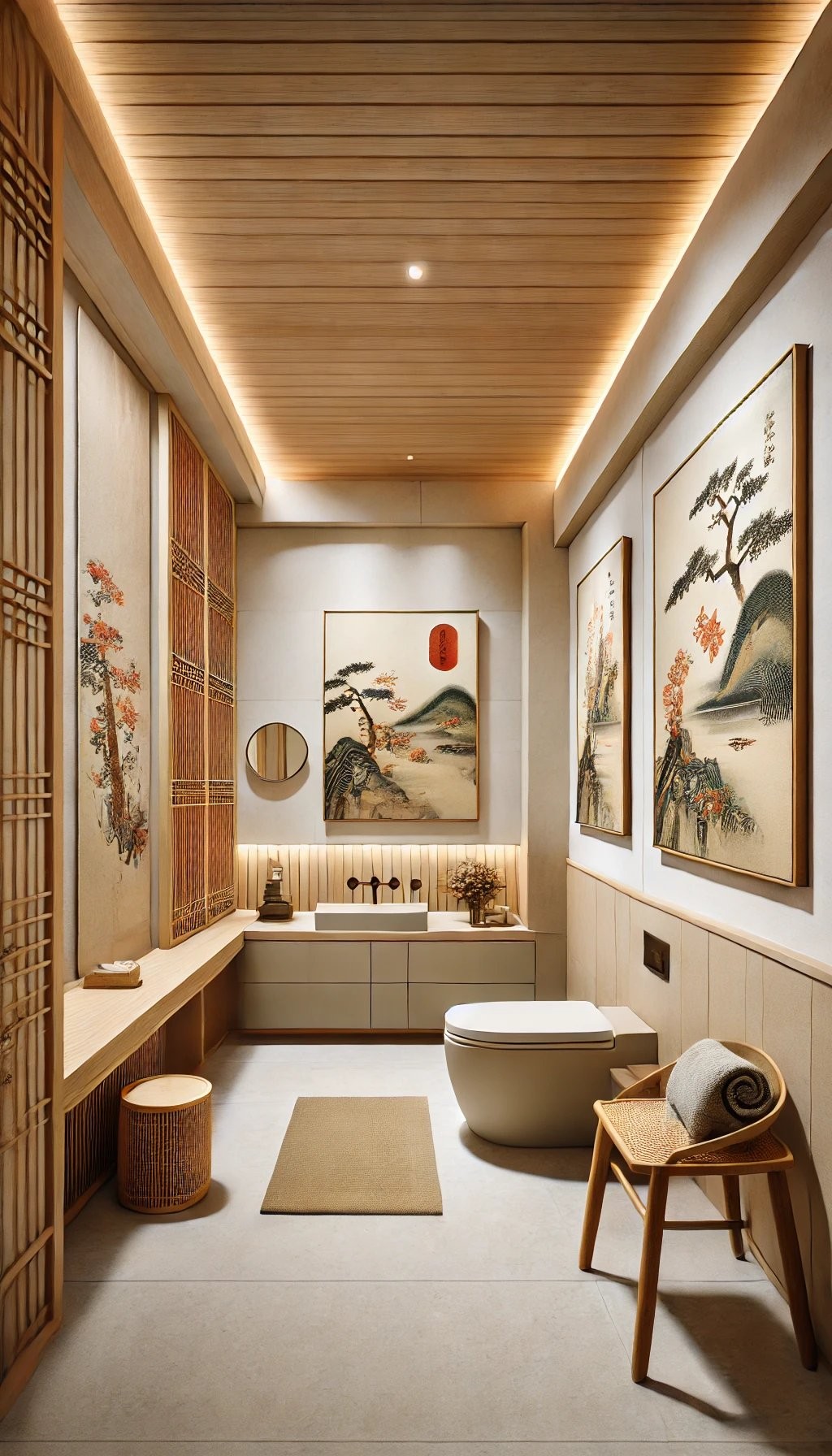
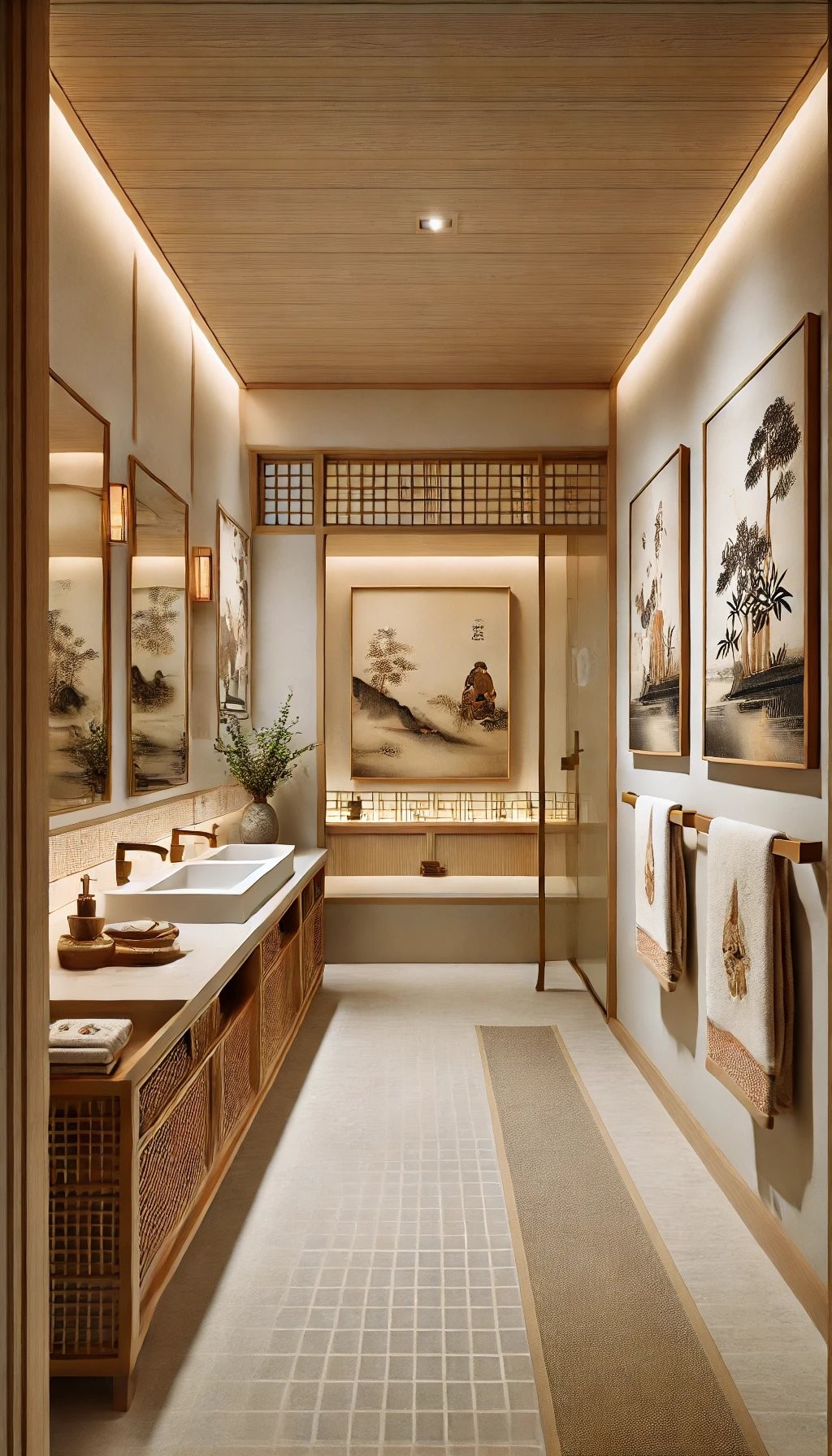
Transforming your bathroom with traditional Japanese art and décor elements adds a layer of cultural sophistication. Consider incorporating artwork, wall hangings, and other decorative pieces that embody Japanese aesthetics. These thoughtful touches can effortlessly elevate a mundane bathroom into an immersive space rich in history and charm. As artist Yayoi Kusama so eloquently puts it, ‘With just one polka dot, nothing can be achieved.
‘ Similarly, by incorporating deliberate design elements, you can create a sense of harmony and balance within your bathroom that is both visually striking and culturally nuanced.
Natural Stone Tiles

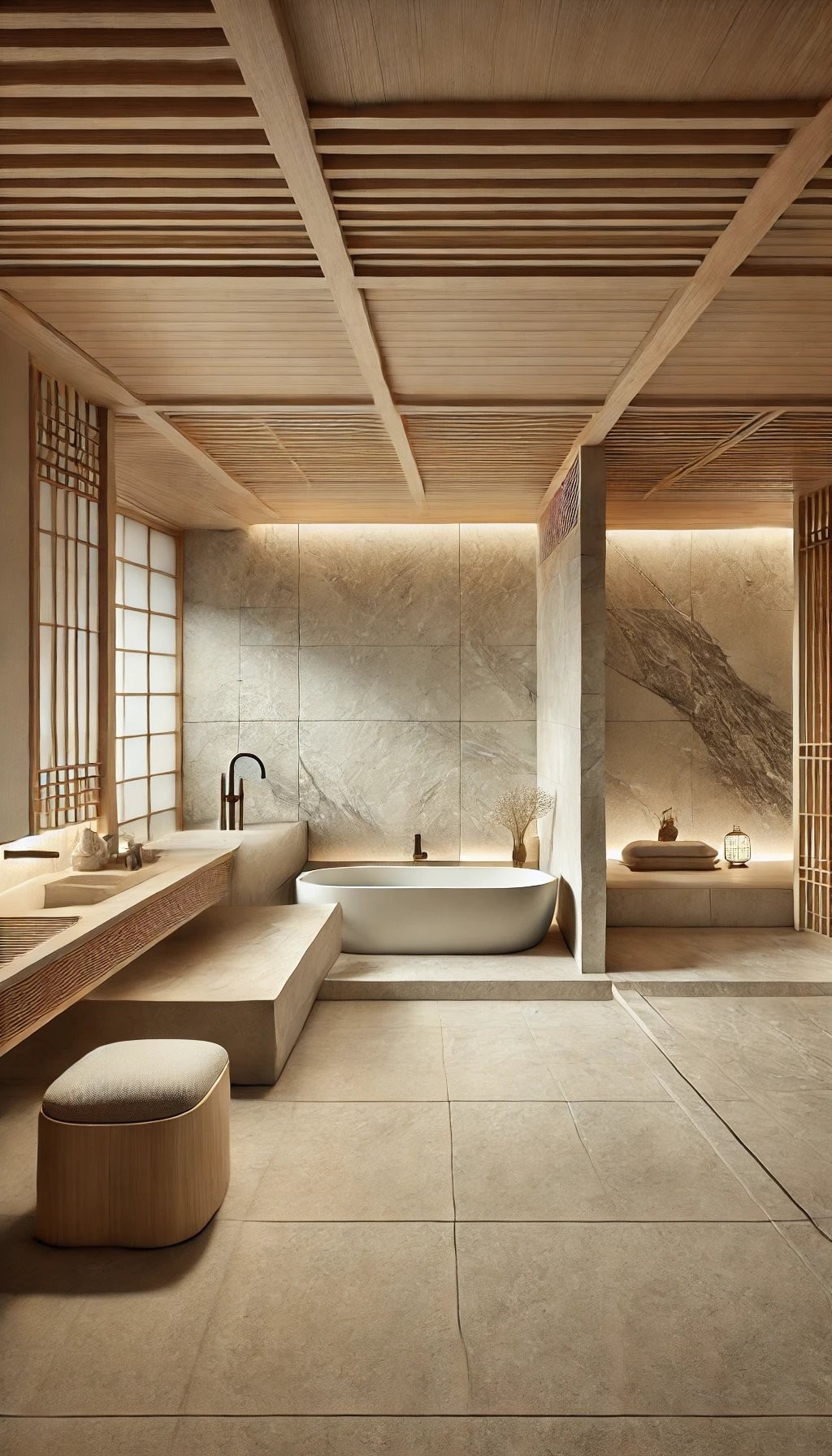
By incorporating natural stone tiles into your bathroom’s walls and floors, you can effortlessly bring the outdoors in. These tiles not only boast durability but also exude a timeless sophistication that elevates the space. To create a luxurious and serene ambiance reminiscent of nature, consider using stones like marble, slate, or granite. The renowned designer Kengo Kuma aptly summarizes this harmonious approach when he says, ‘The materials we use should be in harmony with the natural world.’
Wooden Accents

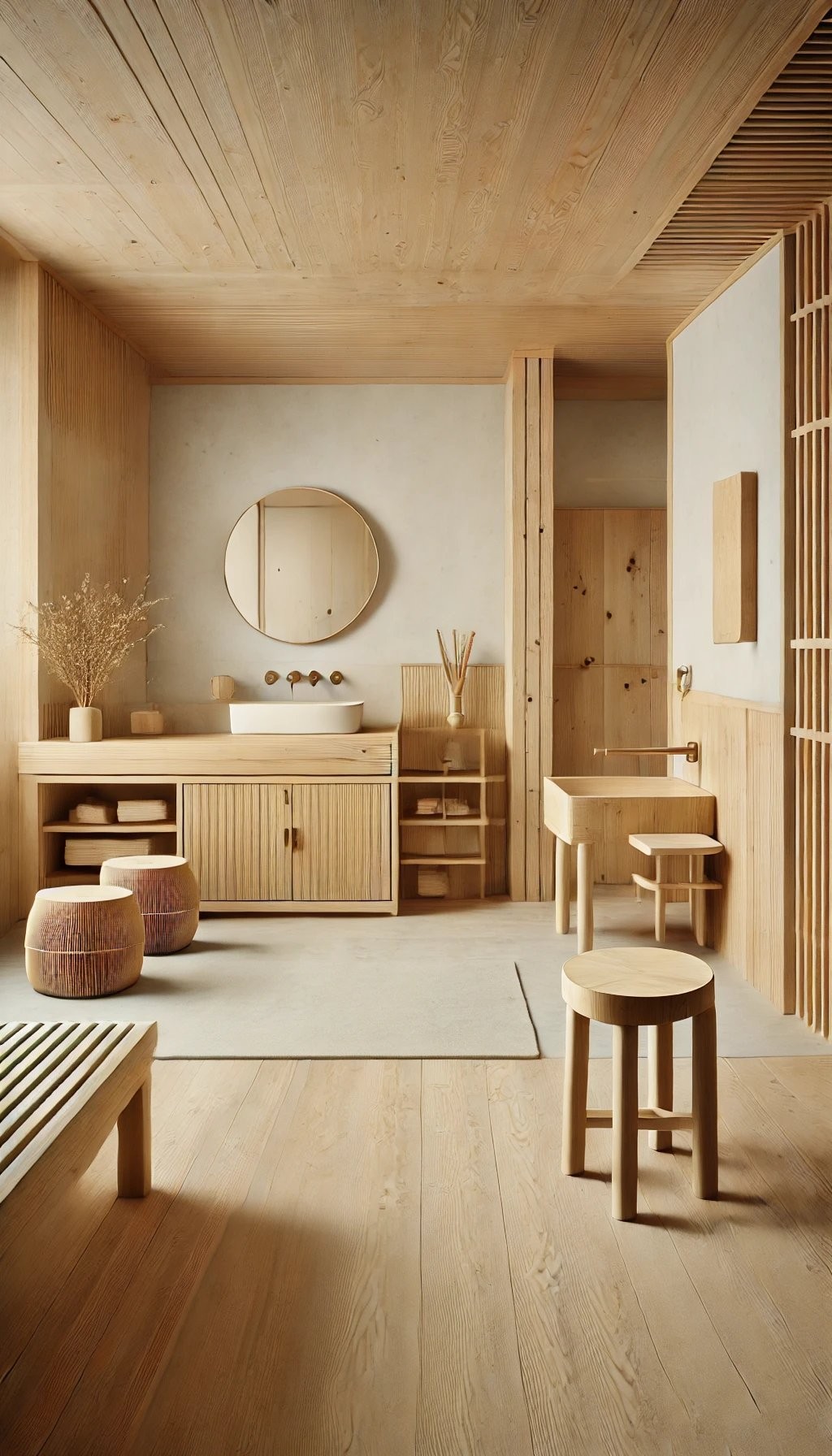
Incorporating wooden accents into your bathroom design can bring a unique warmth and natural charm to the space. To achieve this inviting atmosphere, consider incorporating wooden bath stools, shelving, and other accessories that add texture and visual interest. These elements blend seamlessly with minimalist aesthetics, creating a cozy yet modern look that’s both soothing and stimulating.
As renowned architect Tadao Ando so eloquently puts it, ‘Wood speaks to our heart, stone to our soul’, highlighting the profound emotional connection we have with this natural material.
Rain Showers
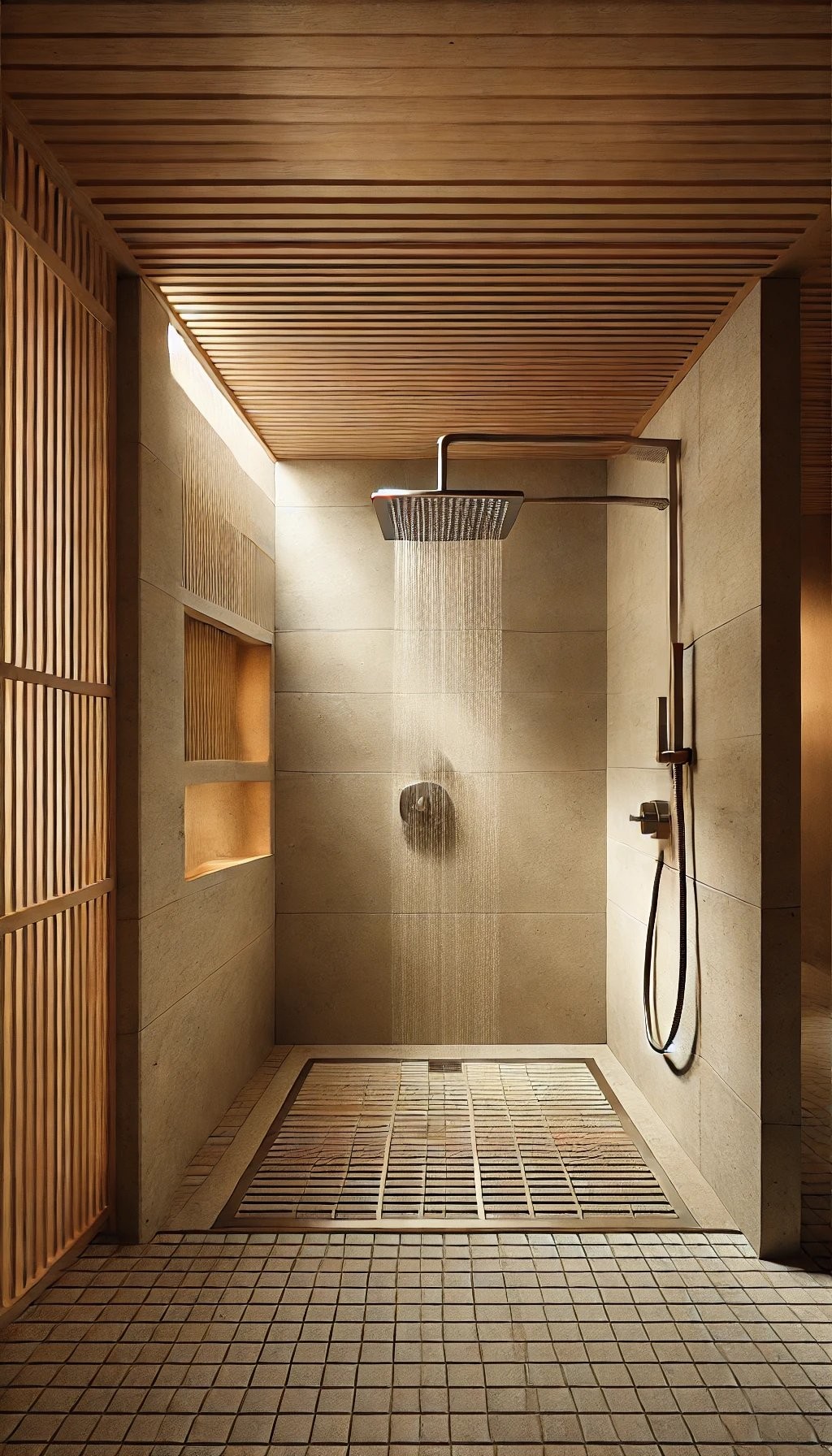
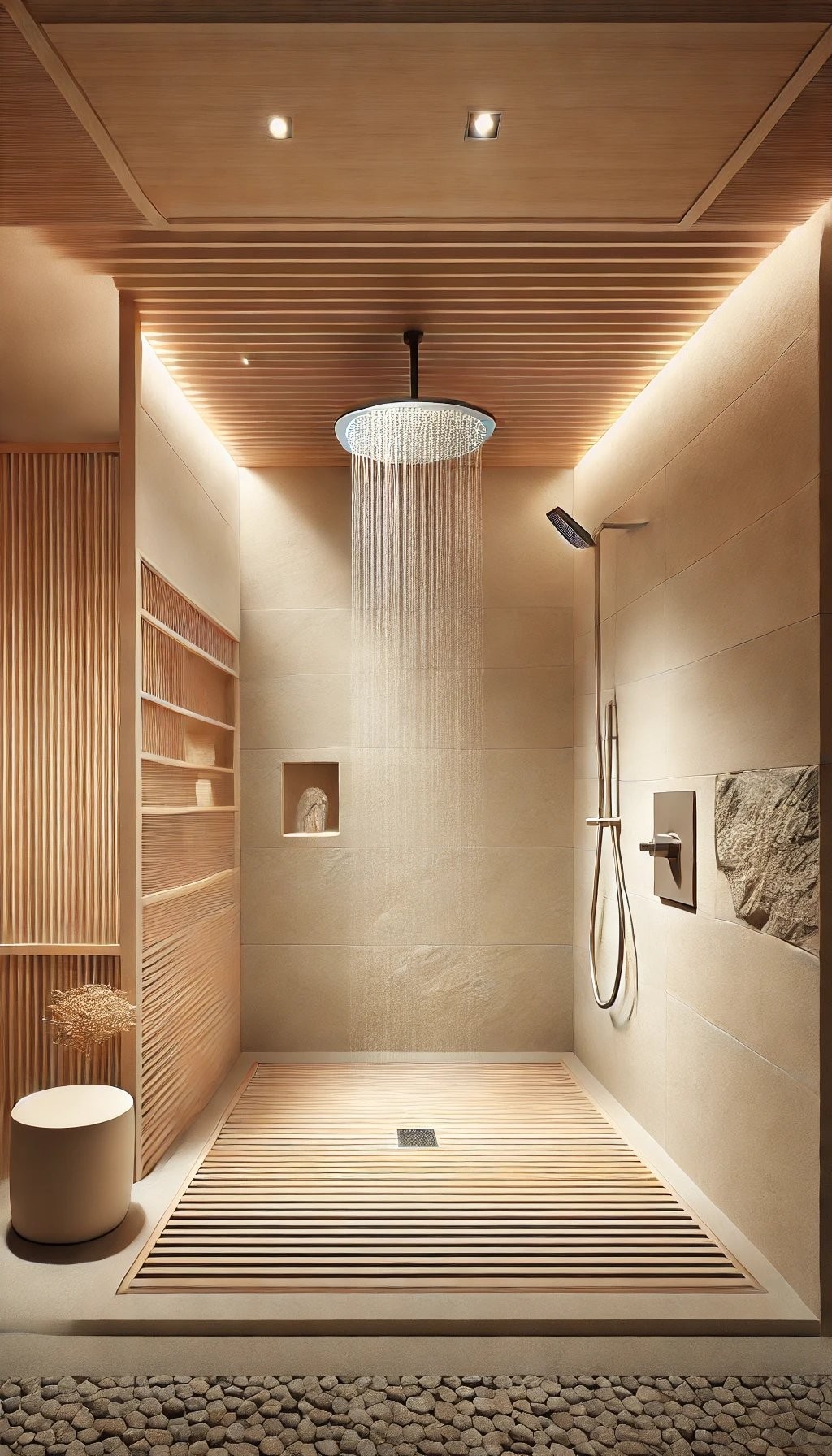
Imagine stepping into your own personal oasis, where the rhythmic patter of raindrops creates a serene ambiance, transporting you to a state of utter relaxation. Rain showers in the comfort of your own home can provide a spa-like experience, reminiscent of natural rainfall. By installing a rain showerhead, you’ll enjoy a gentle and even water flow that envelops your entire body, melting away any tension or stress.
As renowned chef Masaharu Morimoto so aptly put it, ‘A simple shower can be the most luxurious escape’ – allowing yourself to unwind and rejuvenate in the comfort of your own home.
Aromatherapy
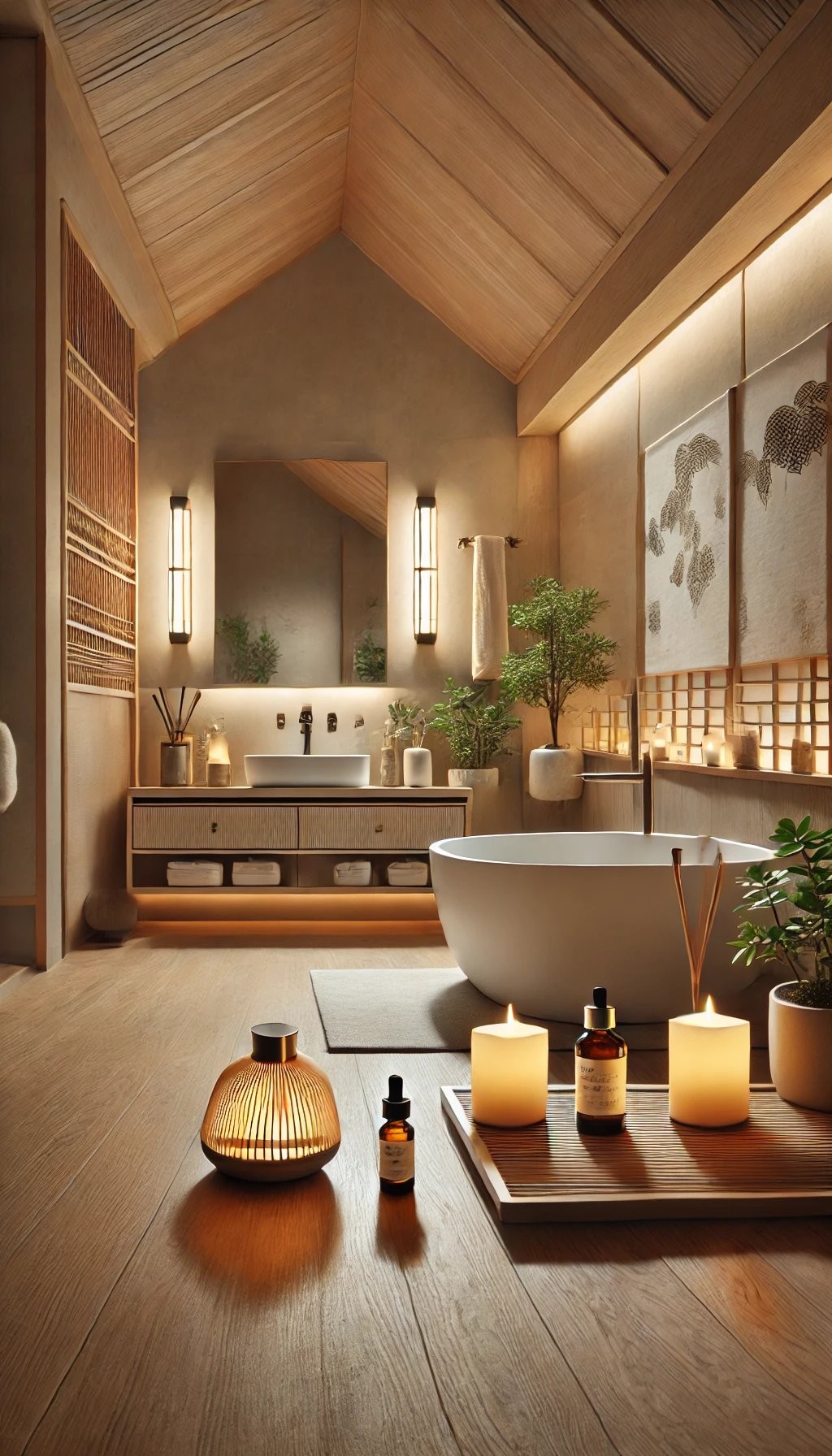
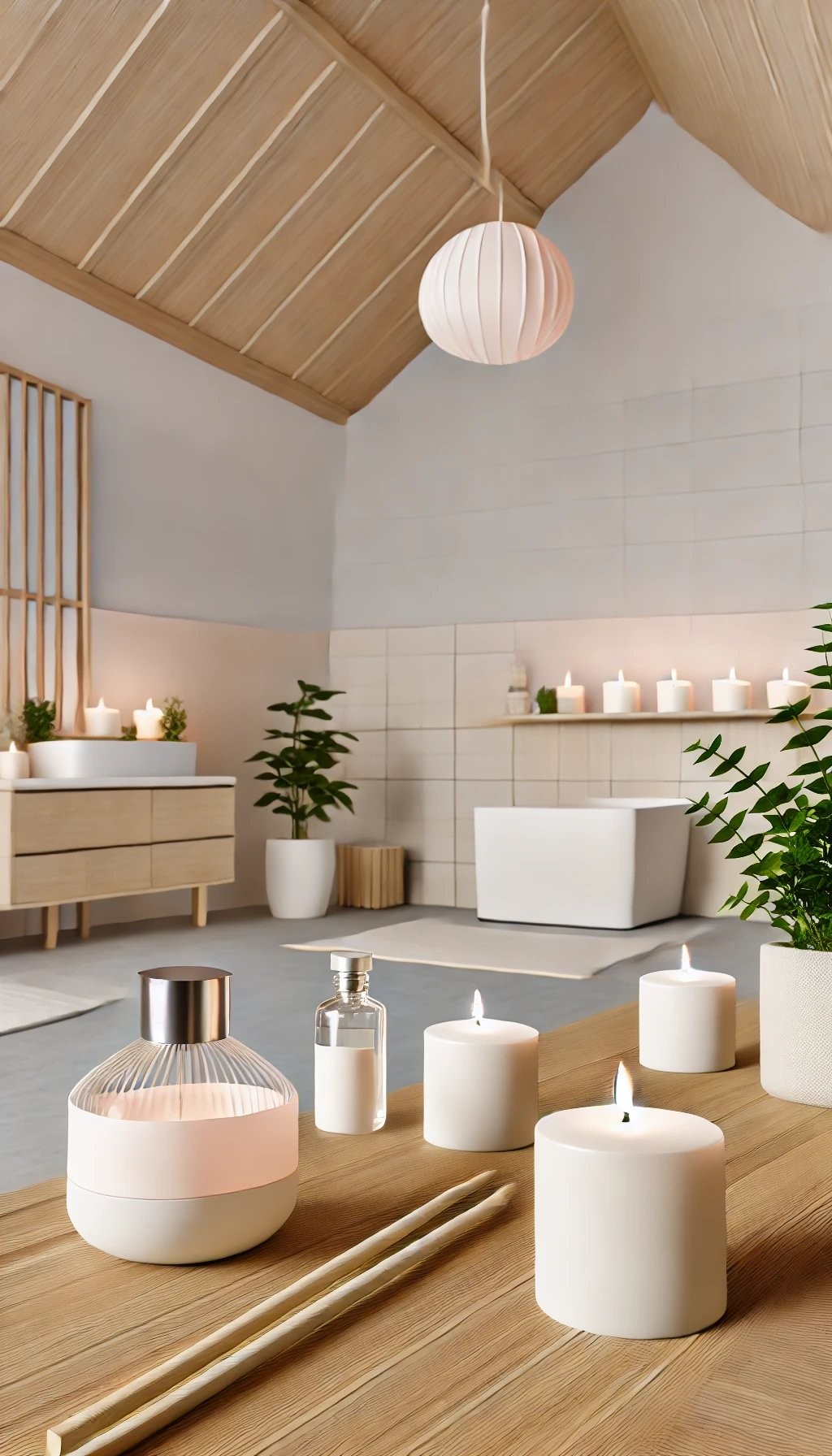
In the serene environment of Japanese bathrooms, aromatherapy plays a significant role in fostering relaxation. By incorporating essential oils, diffusers, and scented candles, individuals can create a tranquil atmosphere that promotes well-being. To achieve this, opt for calming scents like lavender, eucalyptus, and chamomile, which are known to reduce stress and promote relaxation.
As acclaimed author Haruki Murakami aptly puts it, ‘Smell is a potent wizard that transports you to another place’, highlighting the profound impact aromatherapy can have on one’s state of mind.
Smart Toilets
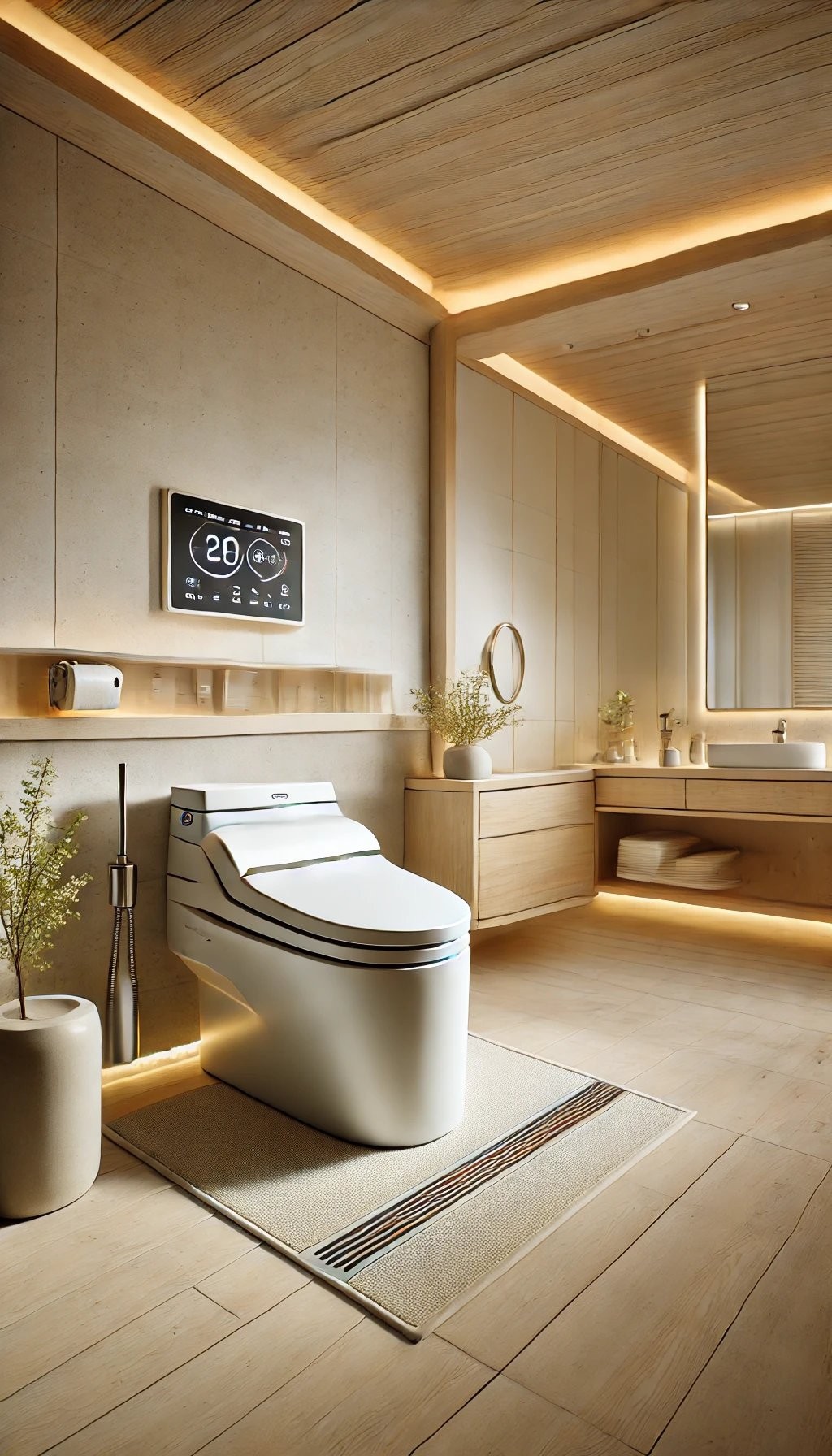
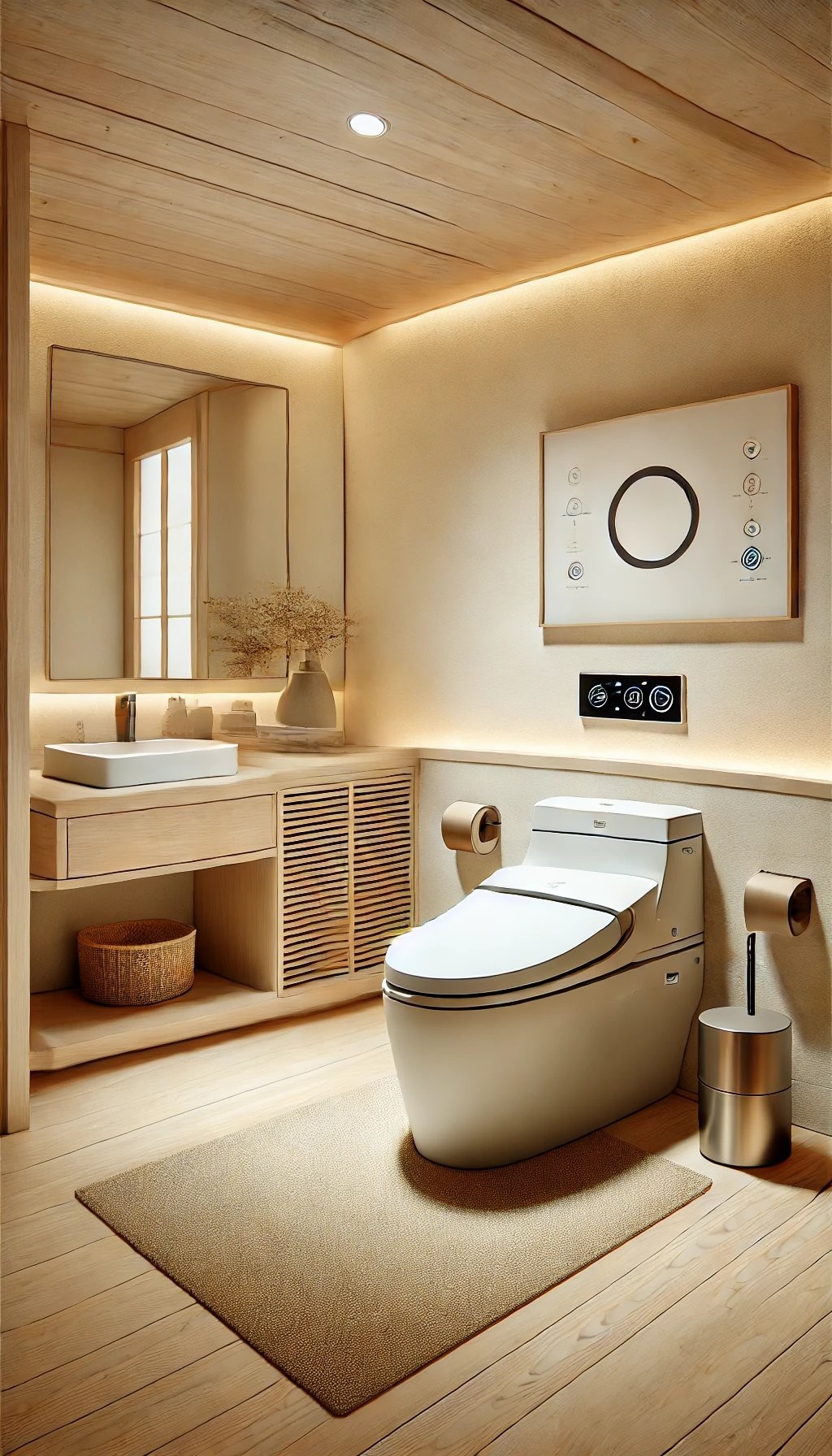
Japan is renowned for its innovative approach to technology, particularly in the realm of toilet innovation. The concept of smart toilets has revolutionized bathroom experiences, offering a range of features that prioritize comfort and hygiene. When selecting a smart toilet, look out for heated seats that provide relief during colder months or after a long day. Automatic flushing ensures a seamless experience, while bidet functions cater to individual preferences.
Furthermore, self-cleaning capabilities guarantee a hygienic environment, aligning with the philosophy of tech innovator Hiroshi Ishiguro, who emphasizes that technology should simplify life rather than complicate it.
Compact Layouts
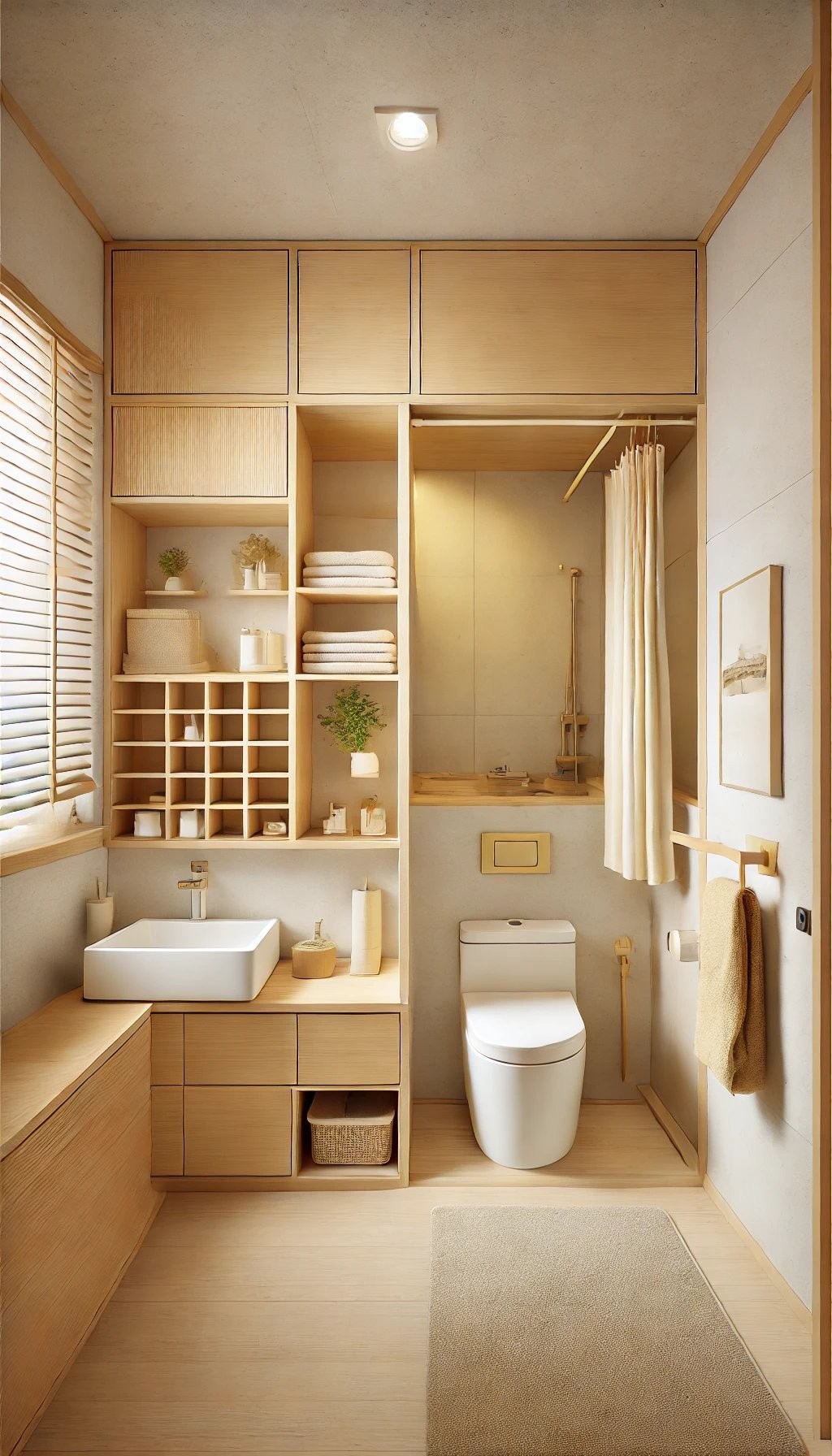
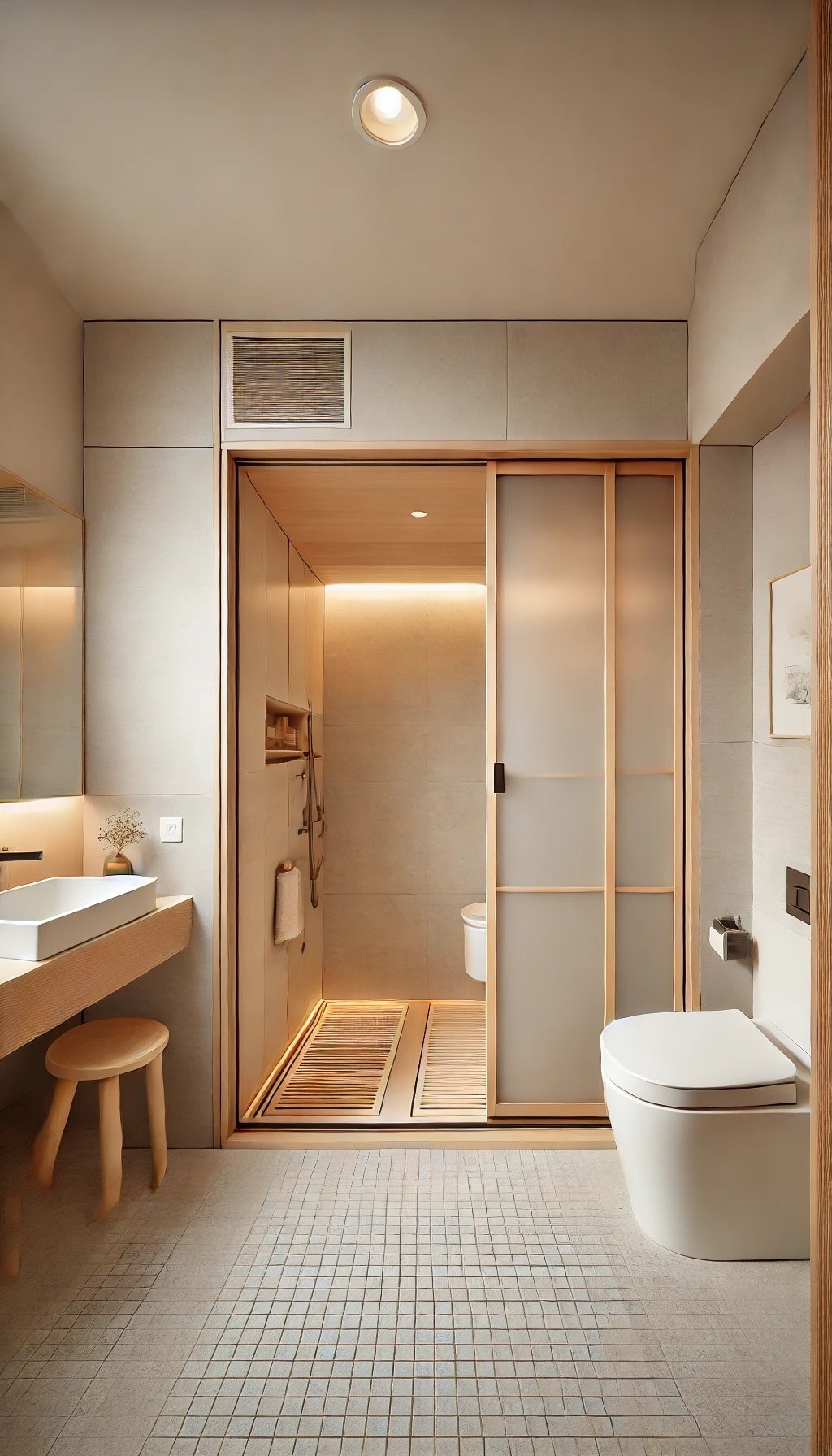
When it comes to bathroom design, creating a compact and efficient layout is crucial for achieving optimal functionality within limited space. One effective approach is to employ space-saving elements such as wall-mounted sinks, floating vanities, and miniature fixtures that won’t encumber the floor area. Mirrors also play a vital role in visually expanding the space, while sliding doors can help eliminate door swings and reclaim precious square footage.
Noted designer Shigeru Ban underscores this concept by noting that even small spaces can be both functional and aesthetically pleasing when designed thoughtfully.
Heated Floors
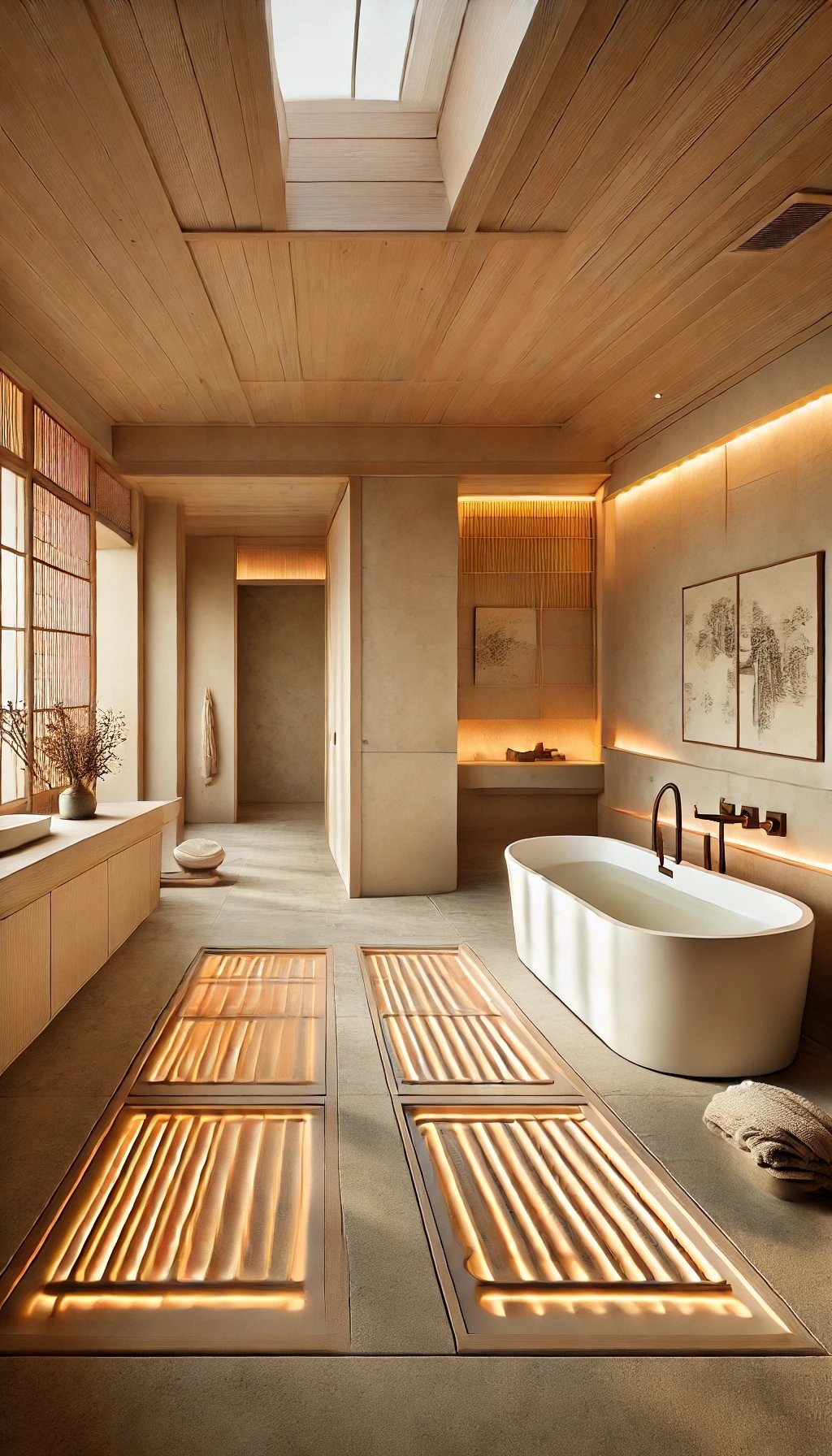
Incorporating heated floors into your bathroom design is a thoughtful touch that elevates the overall experience of using the space, particularly during colder periods. By providing consistent warmth and eliminating the unpleasant shock of cold tiles on bare skin, heated floors can transform the bathroom from functional to indulgent. When it comes to implementation, consider electric or hydronic systems that can be seamlessly integrated beneath tile, stone, or even vinyl flooring.
As renowned architect Frank Lloyd Wright astutely observed, ‘Comfort in architecture lies in the details.’ This simple yet effective detail can make a significant difference in the overall comfort and luxury of your bathroom.
Traditional Bathhouse Aesthetic
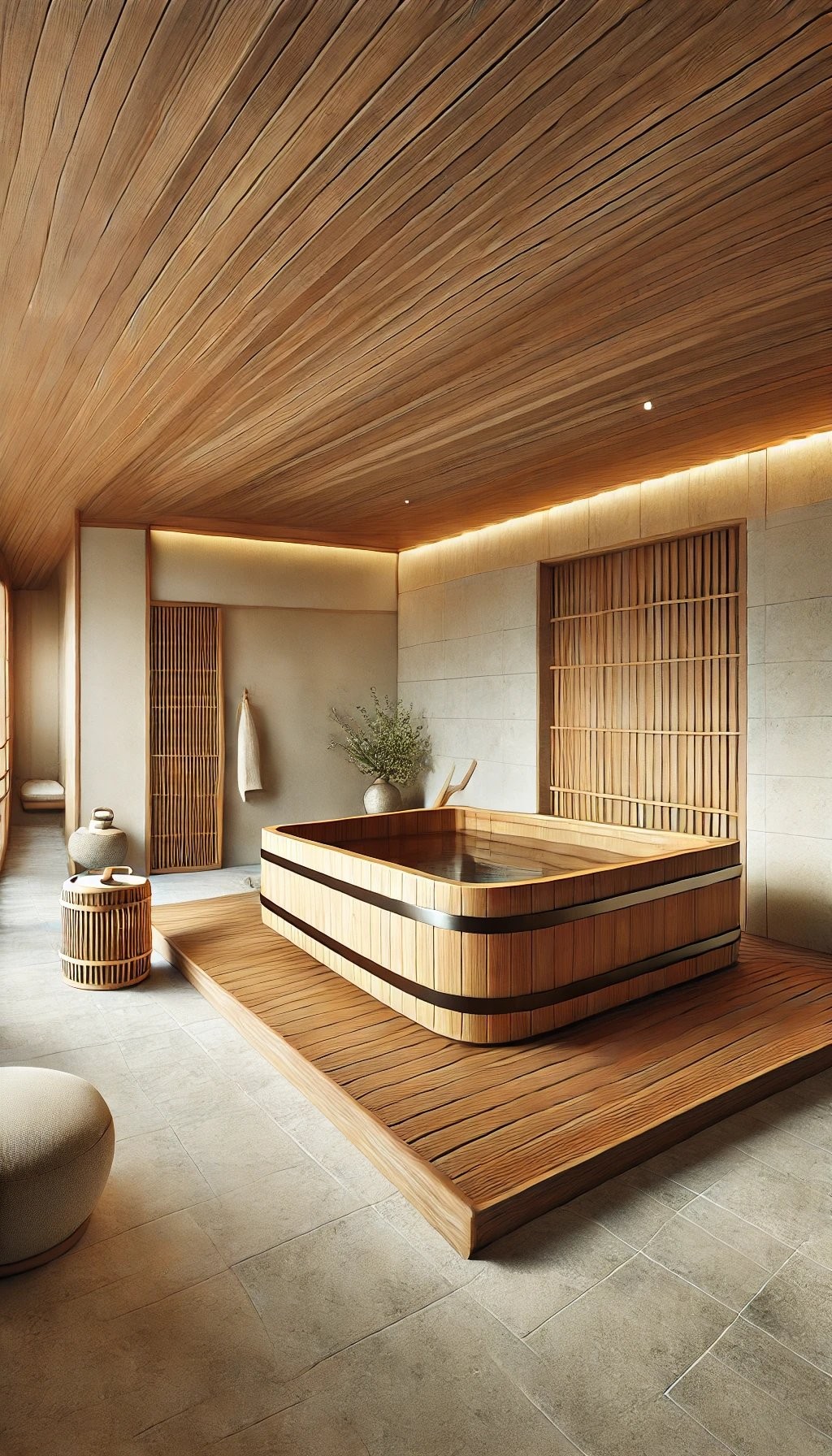
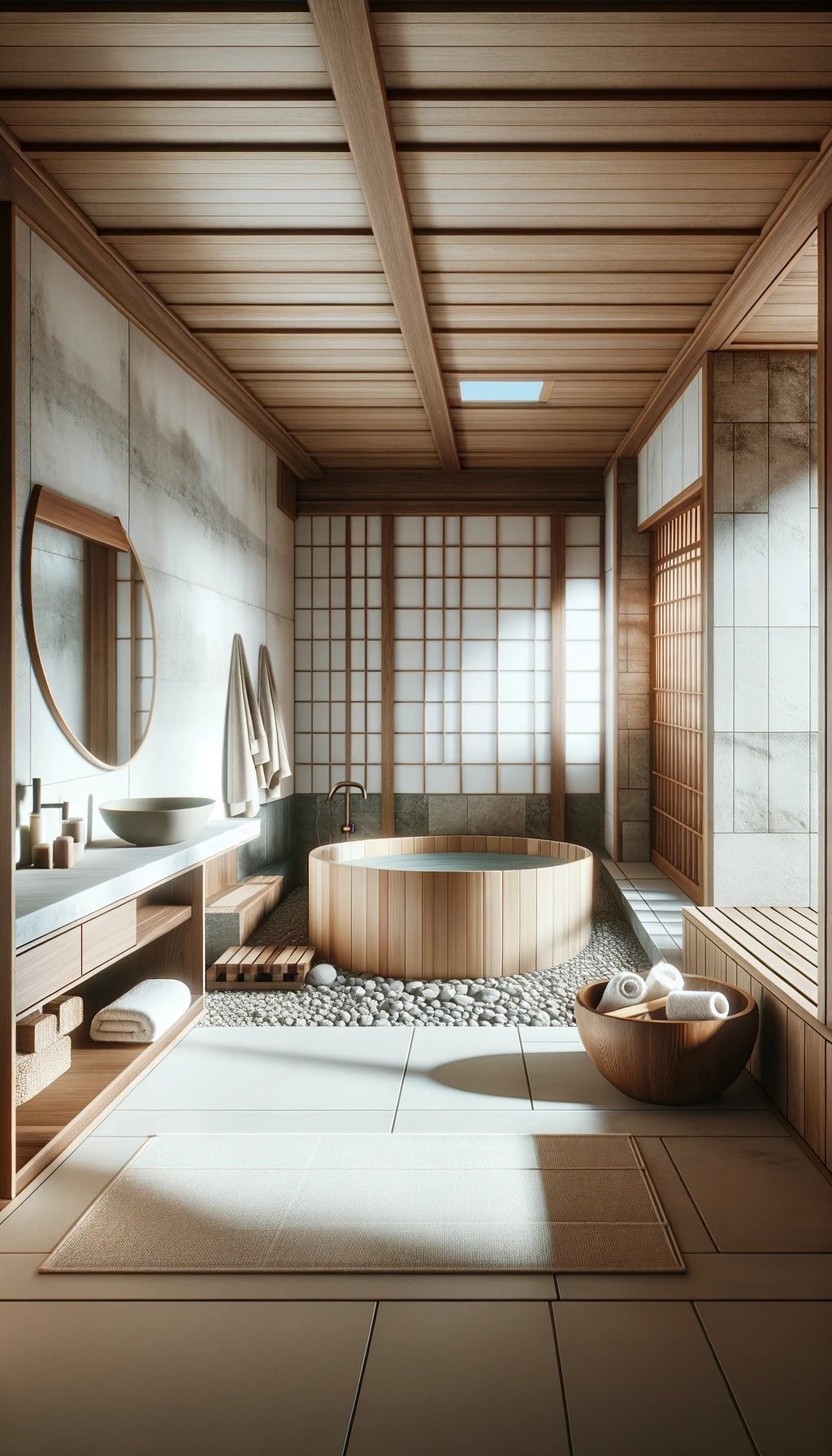
Transform your bathroom into a tranquil oasis reminiscent of traditional Japanese onsen bathhouses. Draw inspiration from the serene and communal atmosphere of these natural retreats by incorporating elements like wooden soaking tubs, stone tiles, and bamboo accents. This design approach not only adds a touch of cultural authenticity but also creates a sense of relaxation and rejuvenation.
As renowned Japanese architect Kengo Kuma notes, ‘A bathhouse is not just a place to cleanse the body, but a space to refresh the spirit.’ By embracing these principles, you can craft a bathroom that transcends mere functionality and becomes a sanctuary for both body and soul.
Water Features
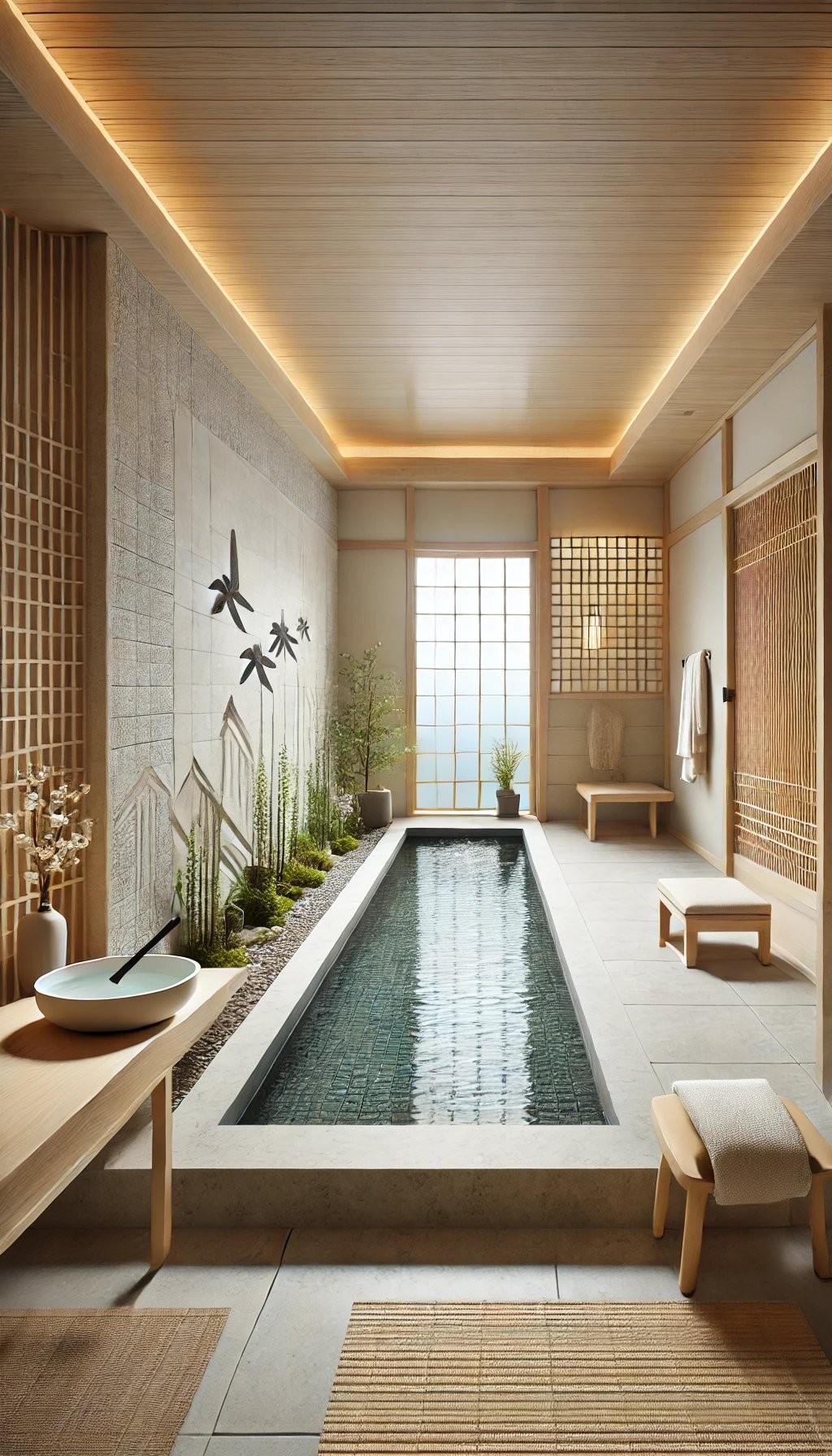
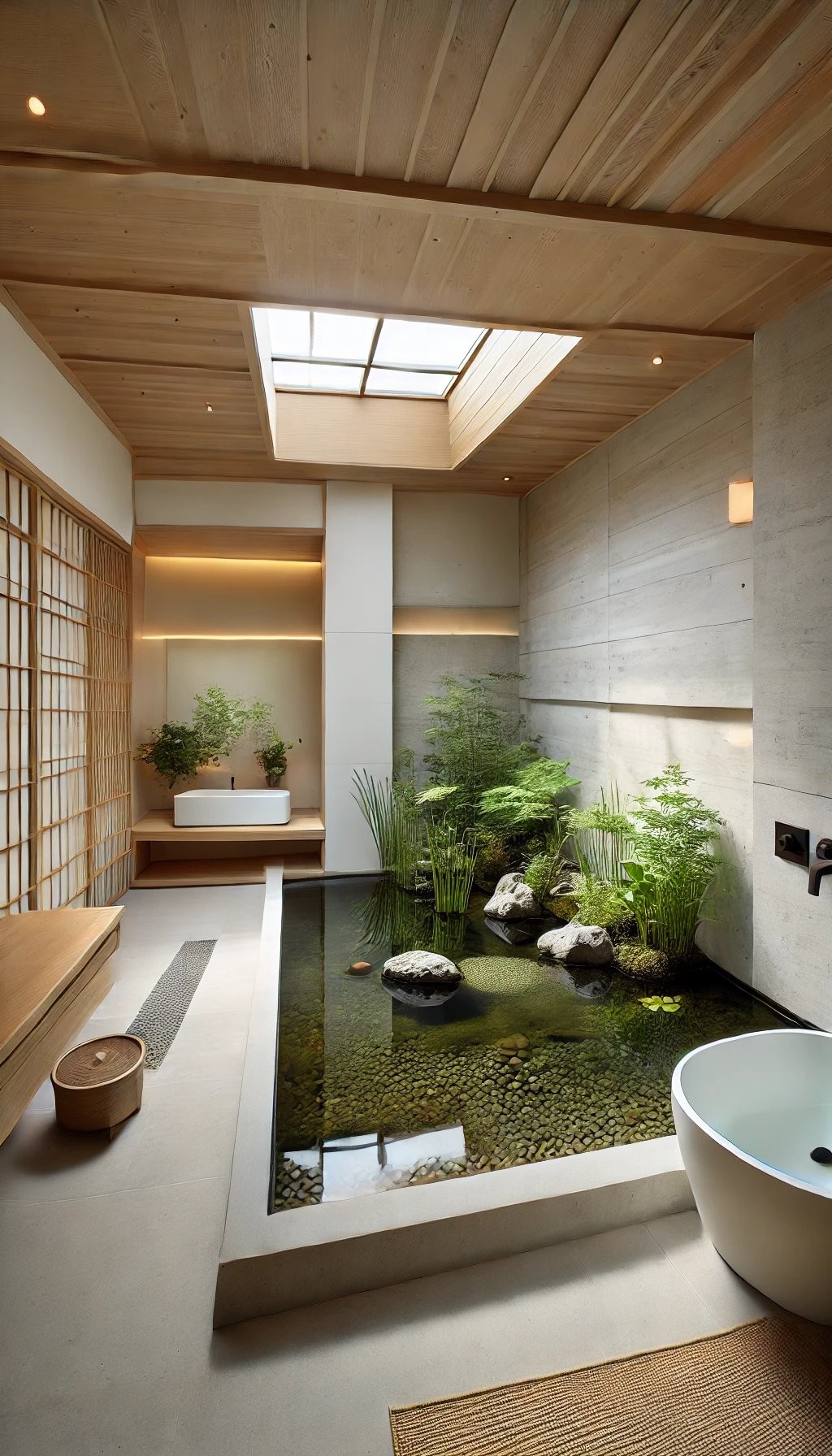
The introduction of water features in your bathroom can instantly transport you to a serene and peaceful environment. The soft gurgling sounds of small fountains, the gentle cascade of water walls, or even the tranquil presence of an indoor pond can work wonders for creating a sense of calm. By incorporating these natural elements into your bathroom design, you’re not only adding visual appeal but also bringing a touch of the outdoors in.
As landscape designer Isamu Noguchi so aptly put it, ‘Water is the most expressive element in nature.’ This expression is particularly powerful when harnessed within the confines of a bathroom, where a sense of relaxation and rejuvenation is often the ultimate goal.
Conclusion
Transforming your bathroom with Japanese design elements can transport you to a serene and functional retreat. By combining the simplicity of minimalist layouts, the warmth of wooden accents, and the luxury of heated floors, you can create a space that seamlessly blends aesthetics and practicality. To further enhance relaxation, incorporate natural elements like indoor plants and water features.
Drawing inspiration from traditional Japanese bathhouses, you can craft a sanctuary that refreshes both body and spirit. As Kengo Kuma, a renowned Japanese architect, so eloquently put it, ‘In Japanese culture, a bathroom is a place of relaxation and meditation.’ By embracing these concepts, you can create a bathroom that’s not only visually stunning but also a haven of calm and tranquility.
FAQs
What are the key features of Japanese bathroom design?
Japanese bathroom design is all about embracing simplicity and harmony with nature. The core principles include the strategic use of natural materials, such as wood and stone, to bring warmth and texture to the space. A calming atmosphere is achieved through a combination of neutral color palettes, sleek fixtures, and thoughtful placement of indoor plants. Water features, like rainfall showerheads or freestanding tubs, add to the spa-like ambiance.
The overall aim is to craft a bathroom that not only functions well but also serves as a tranquil retreat, perfect for unwinding and recharging.
How can I incorporate natural materials into my Japanese bathroom?
For a harmonious blend of Japanese aesthetics with natural elements in your bathroom, incorporate materials that evoke the great outdoors. Bamboo, wood, and stone are excellent choices to create a calming atmosphere. Wooden bath mats, bamboo shelving units, or stone sinks and tiles can transport you to a serene environment. The warmth and texture they bring will enhance the sense of tranquility, making your Japanese-inspired bathroom a true oasis.
What are the benefits of having a soaking tub (Ofuro) in my bathroom?
Indulging in an ofuro, a traditional Japanese soaking tub, offers a multitude of benefits that can be savored in the comfort of your own home. The deep, wooden vessel is designed for full-body immersion, allowing you to relax, unwind and reduce stress levels. Furthermore, the ofuro’s unique design promotes improved circulation, leaving you feeling rejuvenated and refreshed.
To amplify its calming effects, place the tub near a window or in a cozy corner, where the soft glow of natural light can further enhance your spa-like experience.
How do I maximize space in a small Japanese bathroom?
To effectively optimize a compact Japanese bathroom’s layout, consider incorporating clever spatial arrangements that minimize visual clutter. By installing built-in shelves, wall-mounted cabinets, and sliding doors, you can maintain an organized ambiance. Moreover, strategic placement of mirrors and light-hued walls can create the illusion of increased space, thereby creating a more airy feel.
What are the benefits of using aromatherapy in a Japanese bathroom?
Transforming the Japanese Bathroom into an Oasis of Serenity The art of aromatherapy has long been revered for its ability to induce relaxation and calmness. In the context of a Japanese bathroom, this practice can be particularly potent, fostering a sense of tranquility that permeates every aspect of one’s being.
By incorporating essential oils, diffusers, and scented candles with soothing scents like lavender and eucalyptus, one can create a peaceful ambiance that effortlessly reduces stress and promotes overall well-being. As the bathroom becomes a personal retreat, it is transformed into an intimate sanctuary where one can unwind and rejuvenate.

